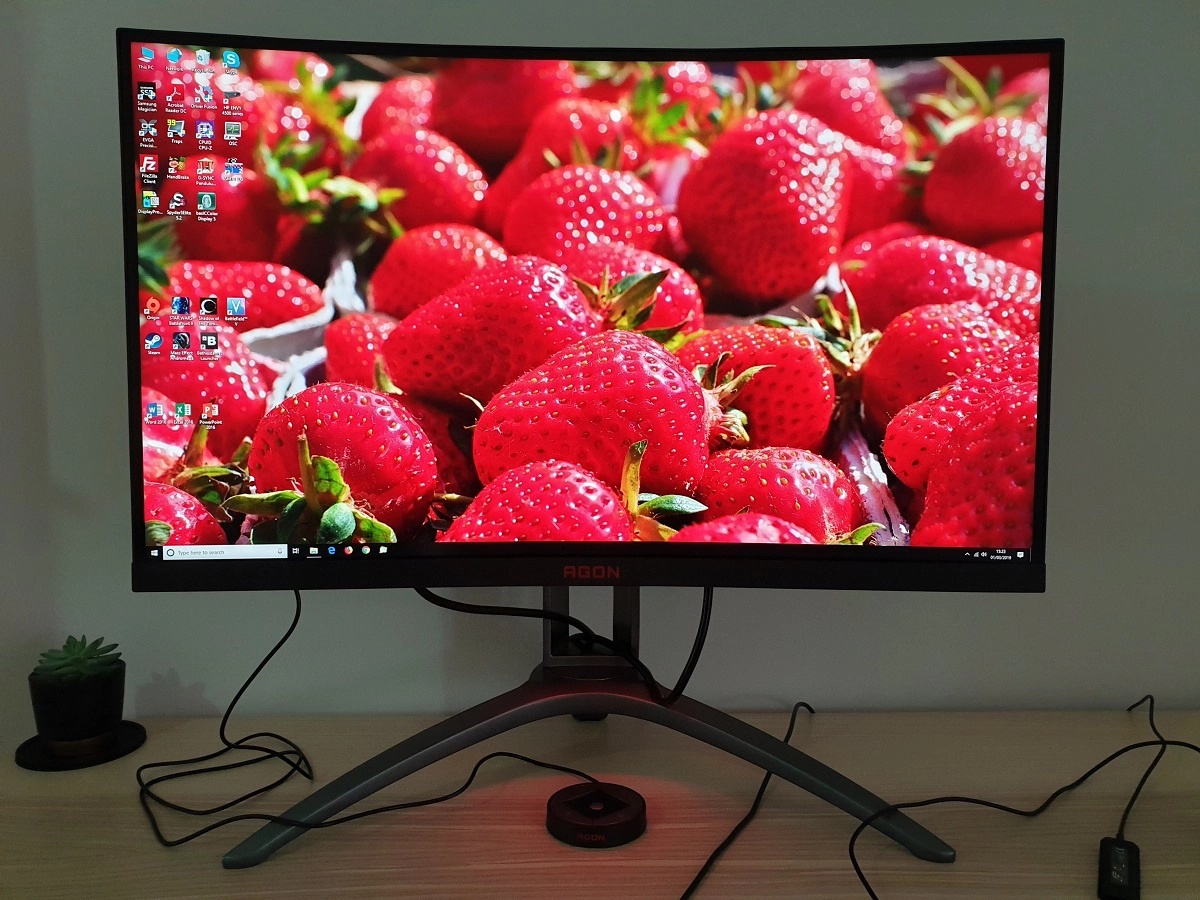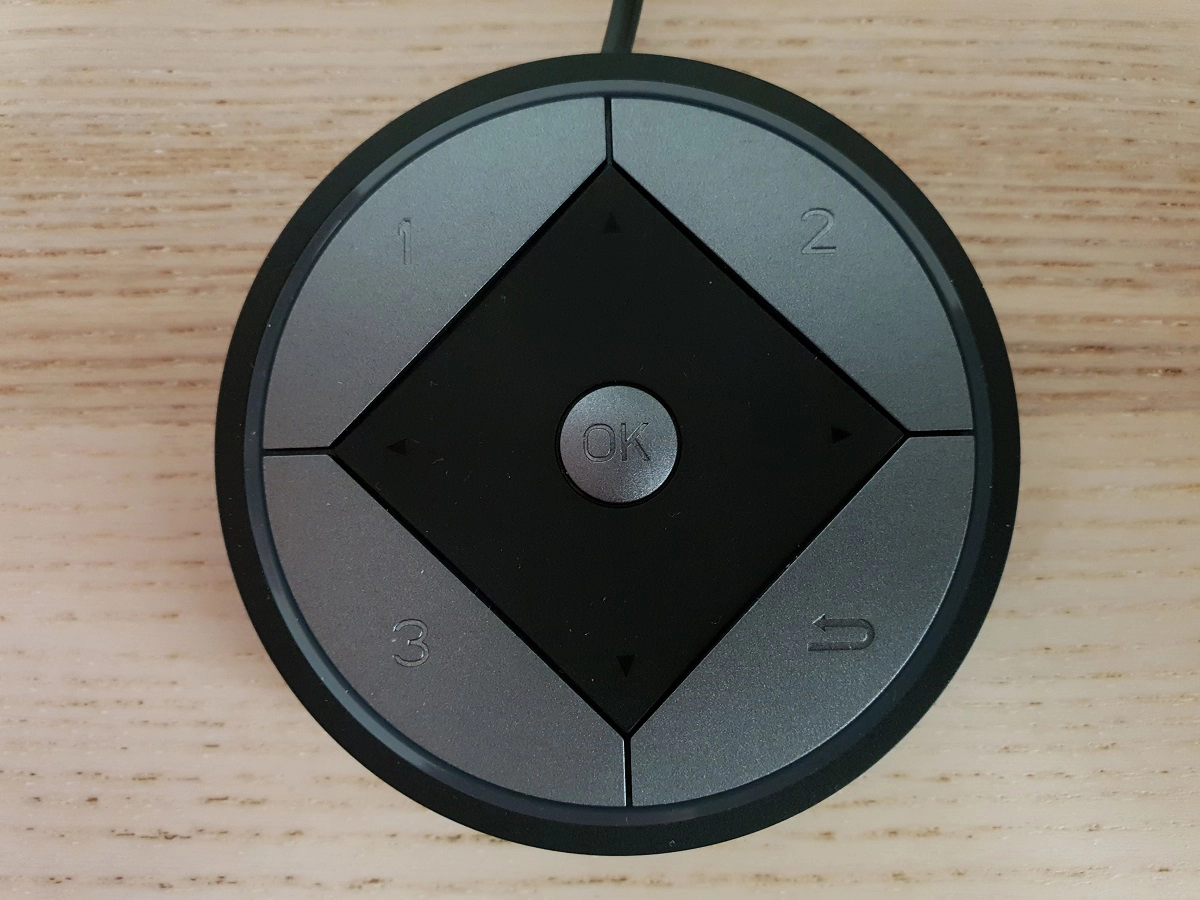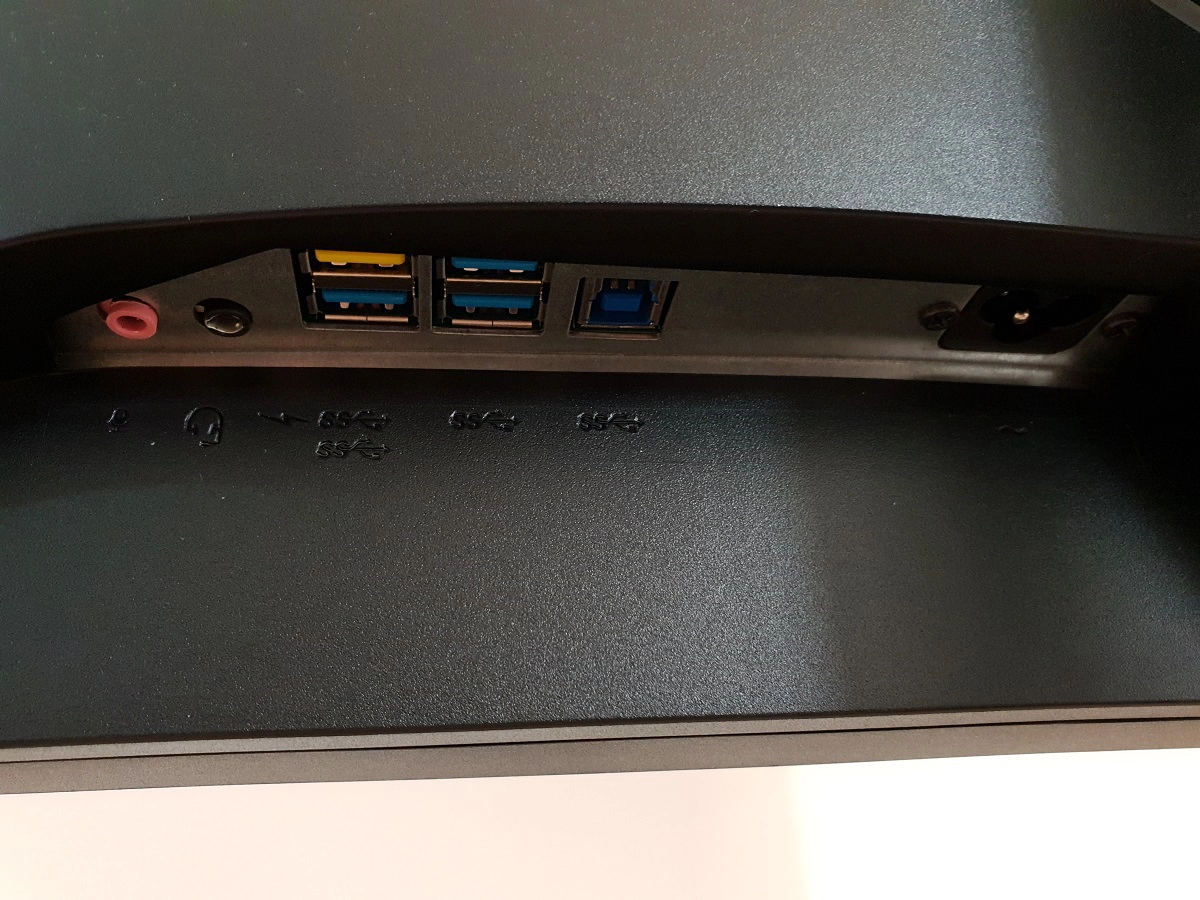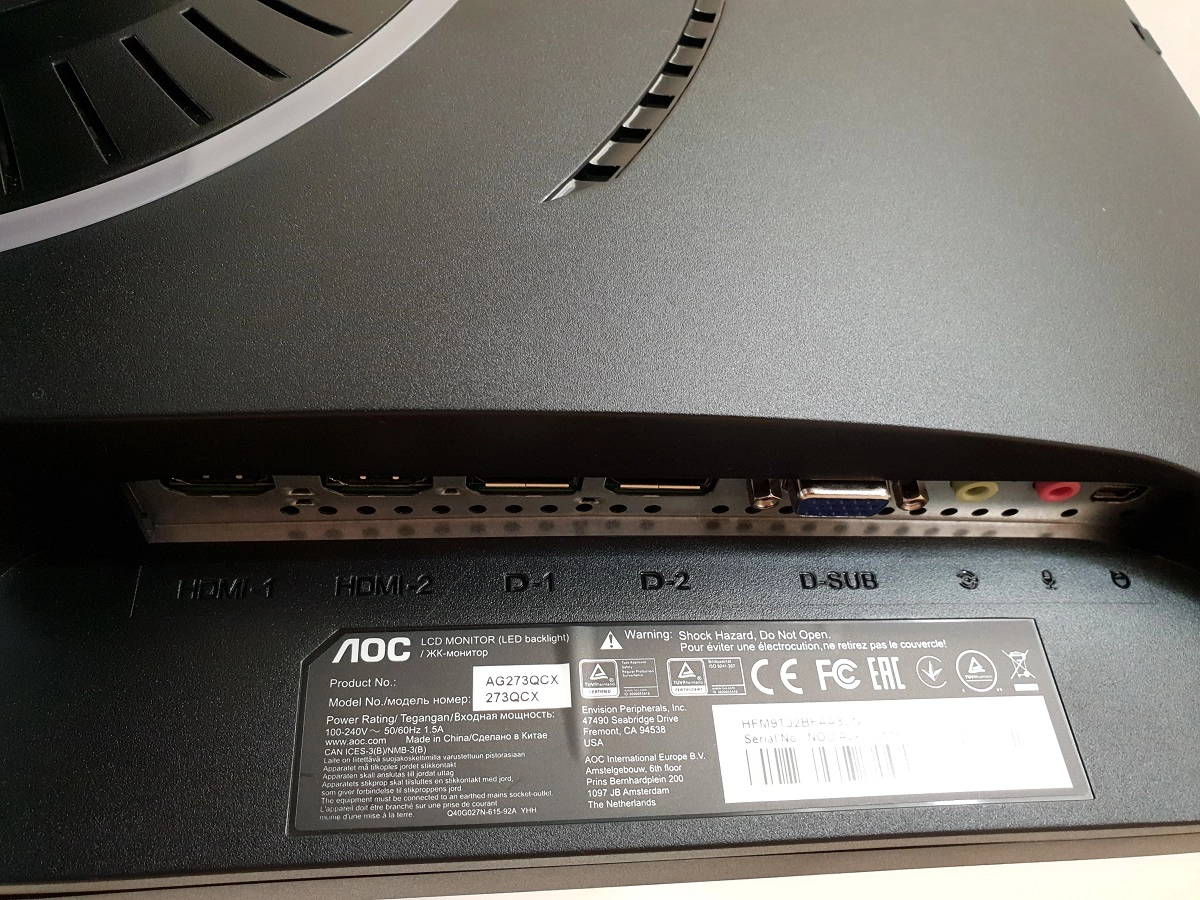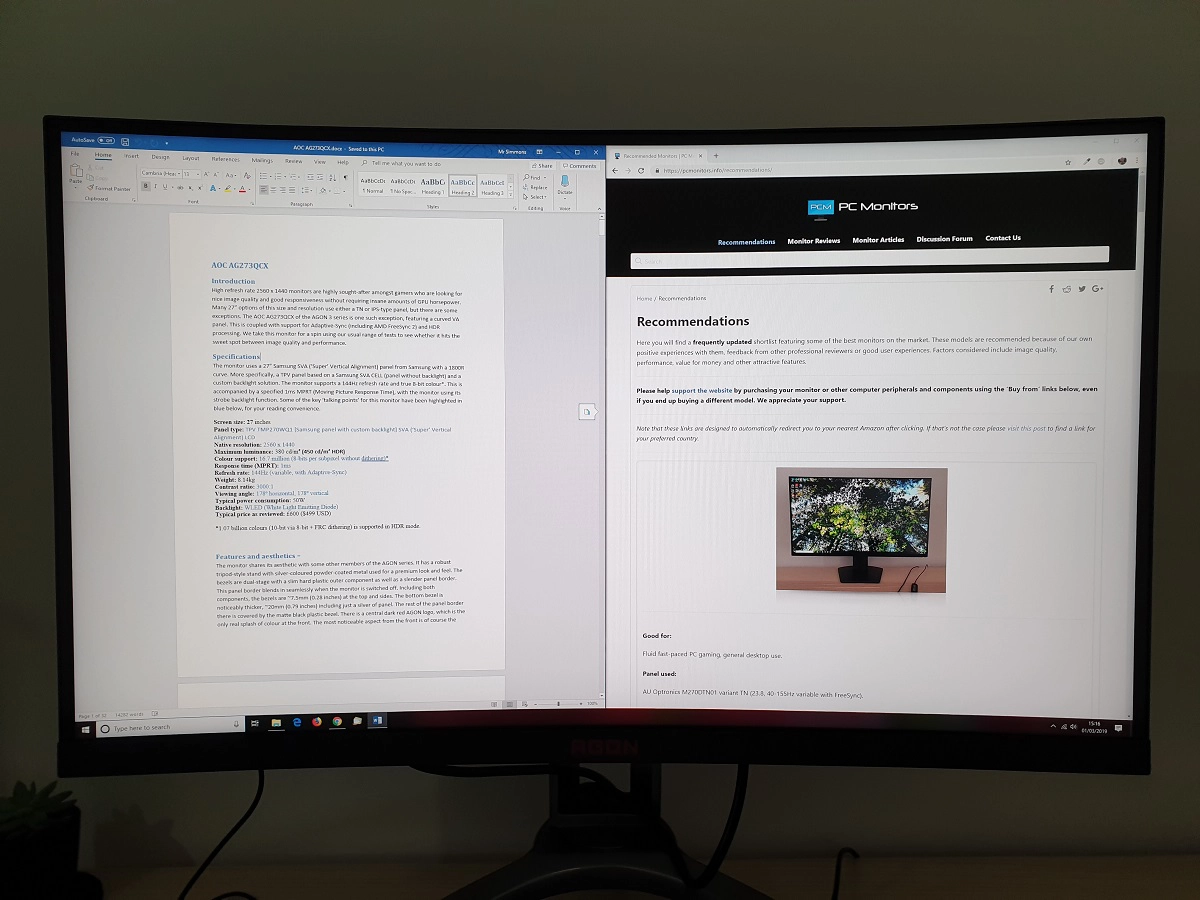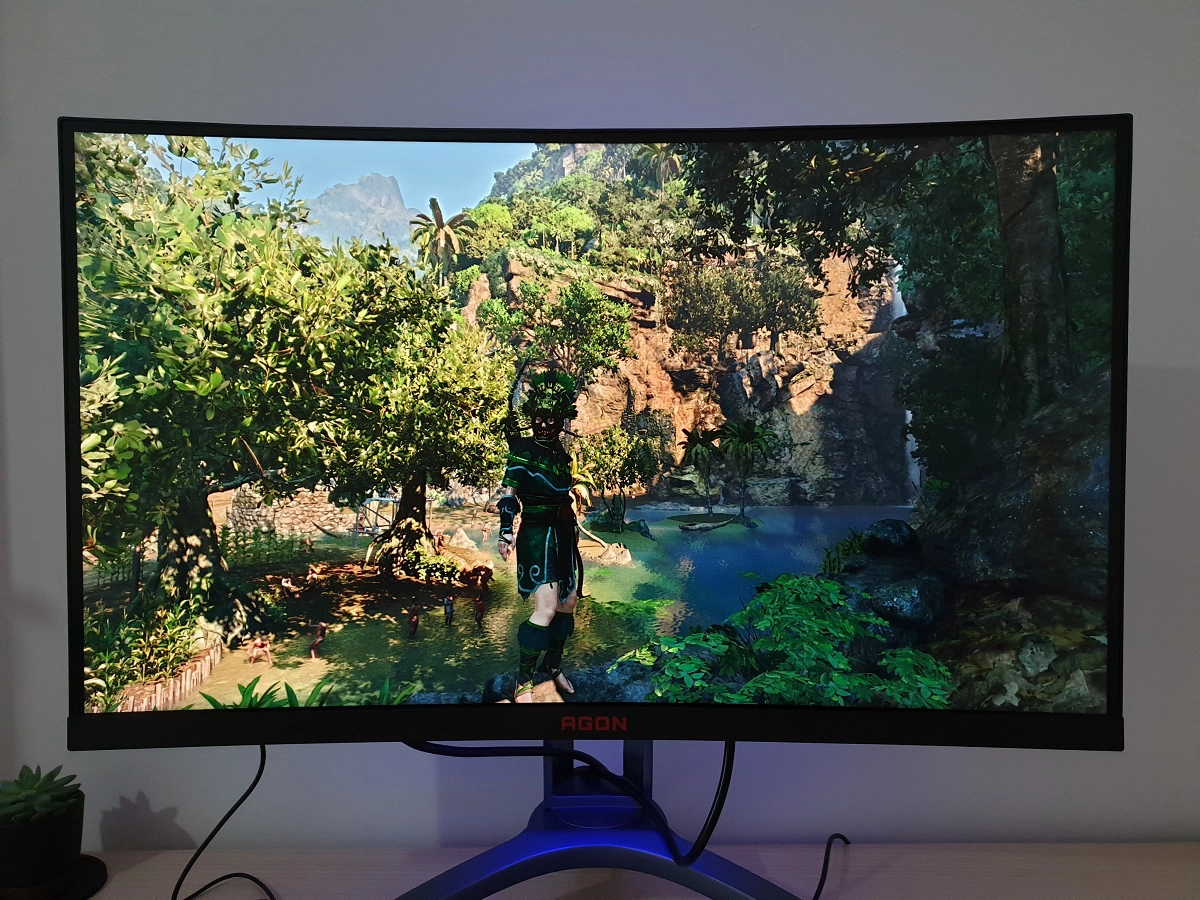Author: Adam Simmons
Date published: March 11th 2019
Table of Contents
Introduction
High refresh rate 2560 x 1440 monitors are highly sought-after amongst gamers who are looking for nice image quality and good responsiveness without requiring insane amounts of GPU horsepower. Many 27” options of this size and resolution use either a TN or IPS-type panel, but there are some exceptions. The AOC AG273QCX of the AGON 3 series is one such exception, featuring a curved VA panel. This is coupled with support for Adaptive-Sync (including AMD FreeSync 2) and HDR processing. We take this monitor for a spin using our usual range of tests to see whether it hits the sweet spot between image quality and performance.
Specifications
The monitor uses a 27” SVA (‘Super’ Vertical Alignment) panel from Samsung with a 1800R curve. More specifically, a TPV panel based on a Samsung SVA CELL (panel without backlight) and a custom backlight solution. The monitor supports a 144Hz refresh rate and true 8-bit colour*. This is accompanied by a specified 1ms MPRT (Moving Picture Response Time), with the monitor using its strobe backlight function. Some of the key ‘talking points’ for this monitor have been highlighted in blue below, for your reading convenience.
The monitor shares its aesthetic with some other members of the AGON series. It has a robust tripod-style stand with silver-coloured powder-coated metal used for a premium look and feel. The bezels are dual-stage with a slim hard plastic outer component as well as a slender panel border. This panel border blends in seamlessly when the monitor is switched off. Including both components, the bezels are ~7.5mm (0.28 inches) at the top and sides. The bottom bezel is noticeably thicker, ~20mm (0.79 inches) including just a silver of panel. The rest of the panel border there is covered by the matte black plastic bezel. There is a central dark red AGON logo, which is the only real splash of colour at the front. The most noticeable aspect from the front is of course the screen itself, which has a 1800R curve and employs a light matte anti-glare screen surface. Both aspects are explored deeper into the review. The OSD (On Screen Display) offers two methods of control. There’s a small joystick which faces downwards under the bottom bezel, beneath the AGON logo. There’s also an ‘AGON Game Pad’, shown in the image below. This is a small wired remote that offers an alternative method to navigate through the OSD. This remote connects via MiniUSB port at the rear of the monitor. Both control methods and the system itself and the are explored in the video below. The video also looks at the ‘Light FX’ feature, a ring of customisable RGB LEDs at the rear of the monitor. From the side the screen is reasonably slim, ~18.5mm (0.73 inches) at thinnest point but lumping out centrally towards the stand attachment point. At both sides of the screen there’s a retractable matte black plastic headphone hook. The robust stand design can be seen from this angle. It includes good ergonomic flexibility; tilt (3.5° forwards, 21.5° backwards), swivel (~30° left and ~30° right) and height adjustment (110mm or 4.33 inches). At lowest stand height, the screen clears the desk by ~90mm (3.54 inches) with the top of the screen ~558mm (18.03 inches) above the desk. Plus an extra ~20mm (0.79 inches) for the carry handle at the top of the stand neck which pokes above the monitor at lowest stand height. The total depth of the monitor including stand is ~260mm (10.24 inches) with the screen close to the front edge of the stand feet. So it’s far from the most compact design on the market, certainly when compared to models like the AOC AG273QCG and moreover something like the Dell S2719DGF. But it isn’t anywhere near as much of a space hog as models like the Samsung C27HG70 with a reticulated arm design. The rear of the monitor is mainly matte black plastic. This is broken up by the silver of the stand, a red and silver AGON logo towards the top and the ‘Light FX’ feature explored earlier. When disabled this region appears a shiny medium-dark grey, but as demonstrated it can be illuminated in a multitude of colours and patterns. The ports of the monitor face downwards and towards the left of the stand neck include; a 3.5mm microphone jack, 3.5mm headphone jack, 4 USB 3.0 ports (one coloured yellow, with fast-charging), USB 3.0 upstream port and an AC power input (internal power converter). The remaining ports are found to the right of the stand neck and include; 2 HDMI 2.0 ports, 2 DP 1.2+ ports (HDR feature set), D-SUB (VGA), 3.5mm line-in and a mini-USB port for the included OSD controller. 2 x 5W integrated DTS speakers feature. There is some decent flexibility offered in the OSD to control the audio, as shown in the video. There are various ‘DTS Sound’ presets and the ability to customise the graphic equalizer settings if preferred. Audiophiles might not consider the sound output as clean, rich or dynamic as they might like. And for gaming or other immersive audio enjoyment you’ll get a better experience from decent standalone speakers or headphones. But the sound output is certainly much fuller, richer and somewhat cleaner than many integrated speaker solutions. We found the ‘Rock’ setting quite decent for bass-heavy music which is done more justice than on most integrated solutions and the ‘Game’ or ‘Live’ setting for general listening. But users will have their own individual preferences. The full capability of the monitor including the 144Hz refresh rate, Adaptive-Sync (includes AMD FreeSync 2) and HDR can be leveraged via DP 1.2+. HDMI 2.0 also supports these features, except for Adaptive-Sync on Nvidia GPUs (‘G-SYNC Compatible Mode). Standard accessories include a DP cable, HDMI cable and power cable, although this may vary between regions and retailers. The images below are macro photographs taken on Notepad with ClearType disabled. The letters ‘PCM’ are typed out to help highlight any potential text rendering issues related to unusual subpixel structure, whilst the white space more clearly shows the actual subpixel layout alongside a rough indication of screen surface. This model uses a light matte anti-glare screen surface with a slightly rough surface texture. This offers good glare handling and preserves vibrancy better than some matte screen surfaces, whilst avoiding a heavy or ‘smeary’ graininess to the image or a layered effect of graininess. There is instead a light ‘misty’ graininess apparent when observing lighting content, so this doesn’t appear as smooth as on some screen surfaces (including the 31.5” variant of this panel as seen on the likes of the AOC AG322QCX). Most VA models, aside from those using this panel, are known to use smooth surface textures that are free from any readily observable graininess. So we would’ve preferred to have seen panel manufacturer Samsung employ a similar screen surface here. As shown above, the monitor uses the standard RGB (Red, Green and Blue) stripe subpixel layout. This is the default expected by modern operating systems such as Microsoft Windows and Apple MacOS. You needn’t worry about text fringing from non-standard subpixel layouts as a Mac user and don’t need to run ClearType as a Windows user – although you may wish to adjust this according to preferences. As is usual for a panel of this type, the subpixels are quite squat with relatively thick black spaces above and below each row. This can contribute to static interlacing patterns, as we explore later. The lettering also shows partial subpixel illumination, whereby some subpixels have the top or bottom half completely ‘on’ whilst the other half is ‘off’. This creates small ‘gaps’ rather than a blended appearance for the letters, which can slightly affect text clarity. This is far milder than the effect you get on some VA models, where the partial subpixel illumination is observed at the top and bottom edges of letters as well. It’s not something that most users will notice or find bothersome and we don’t consider there to be any major issues related to text rendering on this model. The monitor features a range of ‘Game Mode’ image presets; ‘FPS’, ‘RTS’, ‘Racing’ and 3 numbered ‘Gamer’ presets. These settings adjust the OSD settings to various values, apply an annoying sharpness filter and lock off various settings. The numbered ‘Gamer’ presets allow the user to retain some control of the OSD settings but you can’t change the ‘Color Temp.’ mode or make adjustments to colour channels in the ‘Color Setup’ menu. The presets are briefly shown in the OSD video, but we will instead be focusing on more useful manual adjustments here without a ‘Game Mode’ active. The table below gives gamma readings taken using a DataColor Spyder5ELITE and white point measurements taken using a BasICColor SQUID 3 (X-Rite i1Display Pro), alongside general observations. Our test system runs Windows with an Nvidia GTX 1080 Ti connected using the supplied DisplayPort cable. Additional testing was performed using an AMD Radeon RX 580 and also using HDMI 2.0, although static image quality observations did not significantly differ between the GPUs or inputs. No additional monitor drivers or ICC profiles were specifically loaded. The monitor was left to run for over 2 hours before readings were taken or observations made. Aside from our ‘Test Settings’ where various adjustments are made, assume factory defaults are used. The refresh rate was set to 144Hz in Windows, although this didn’t significantly affect the values or observations in this table. When viewing the figures in this table, note that for most PC users ‘6500K’ for white point and ‘2.2’ for gamma are good targets to aim for. Individual targets depend on individual uses, tastes and the lighting environment, however.
*1.07 billion colours (10-bit via 8-bit + FRC dithering) is supported in HDR mode.
As an Amazon Associate I earn from qualifying purchases made using the below link. Where possible, you’ll be redirected to your nearest store. Further information on supporting our work.
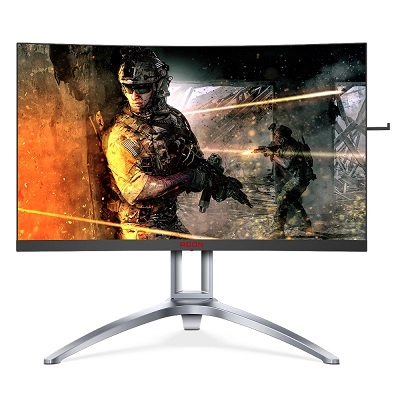
Features and aesthetics
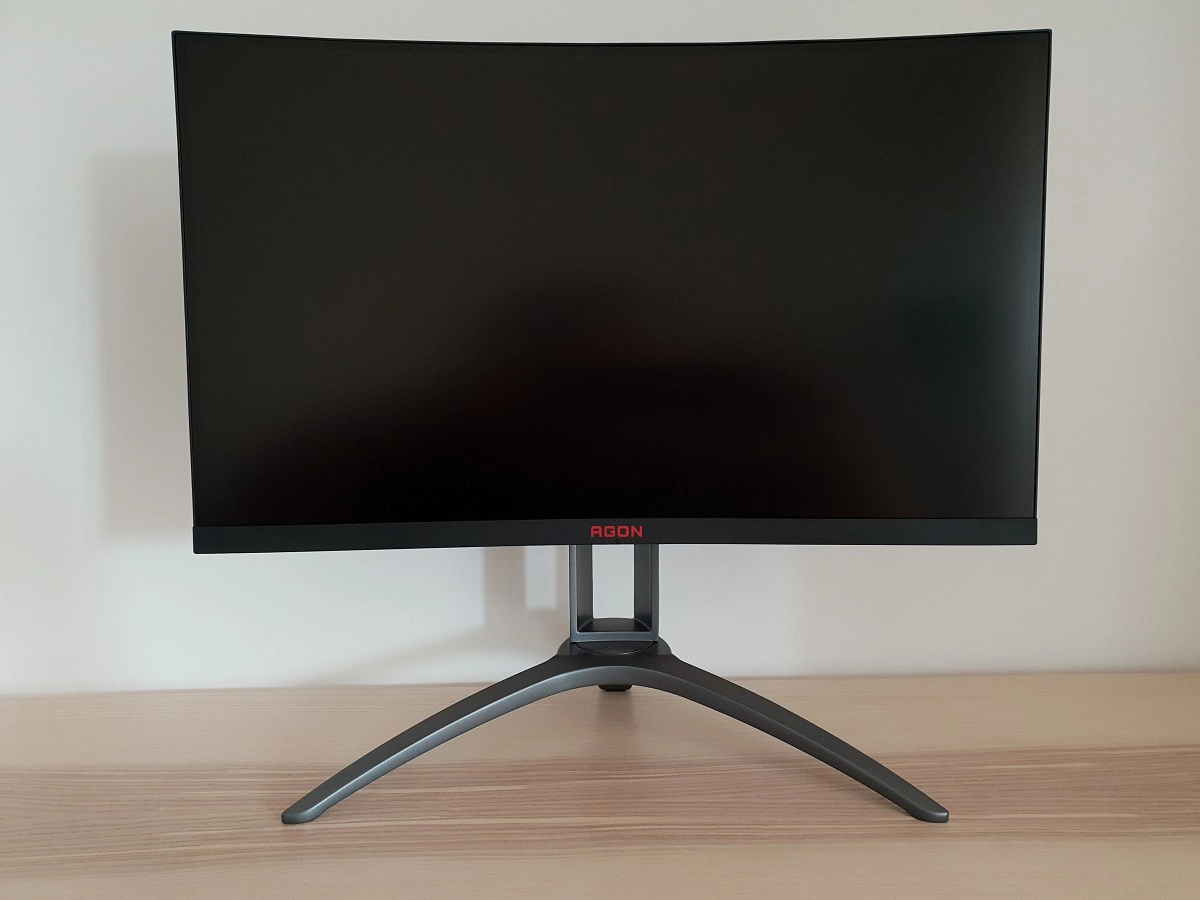
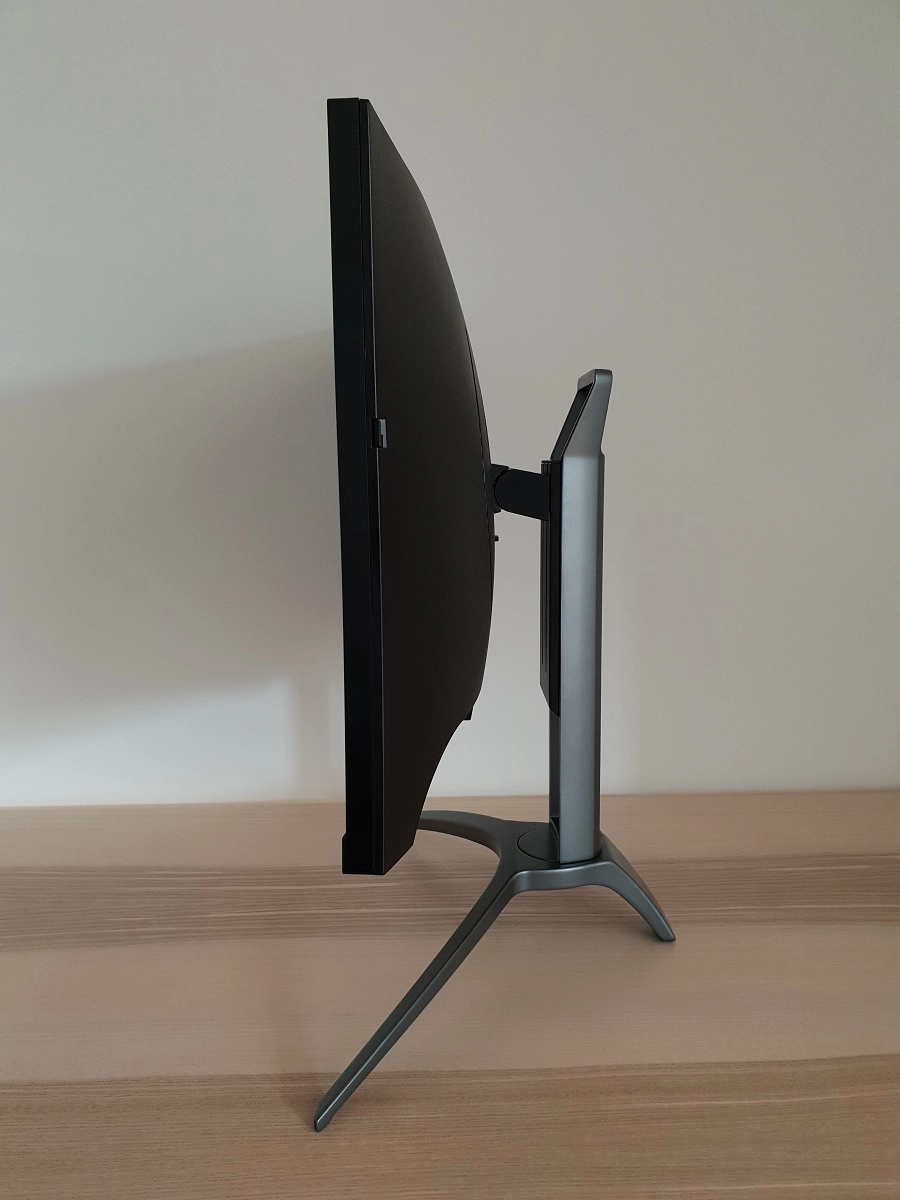
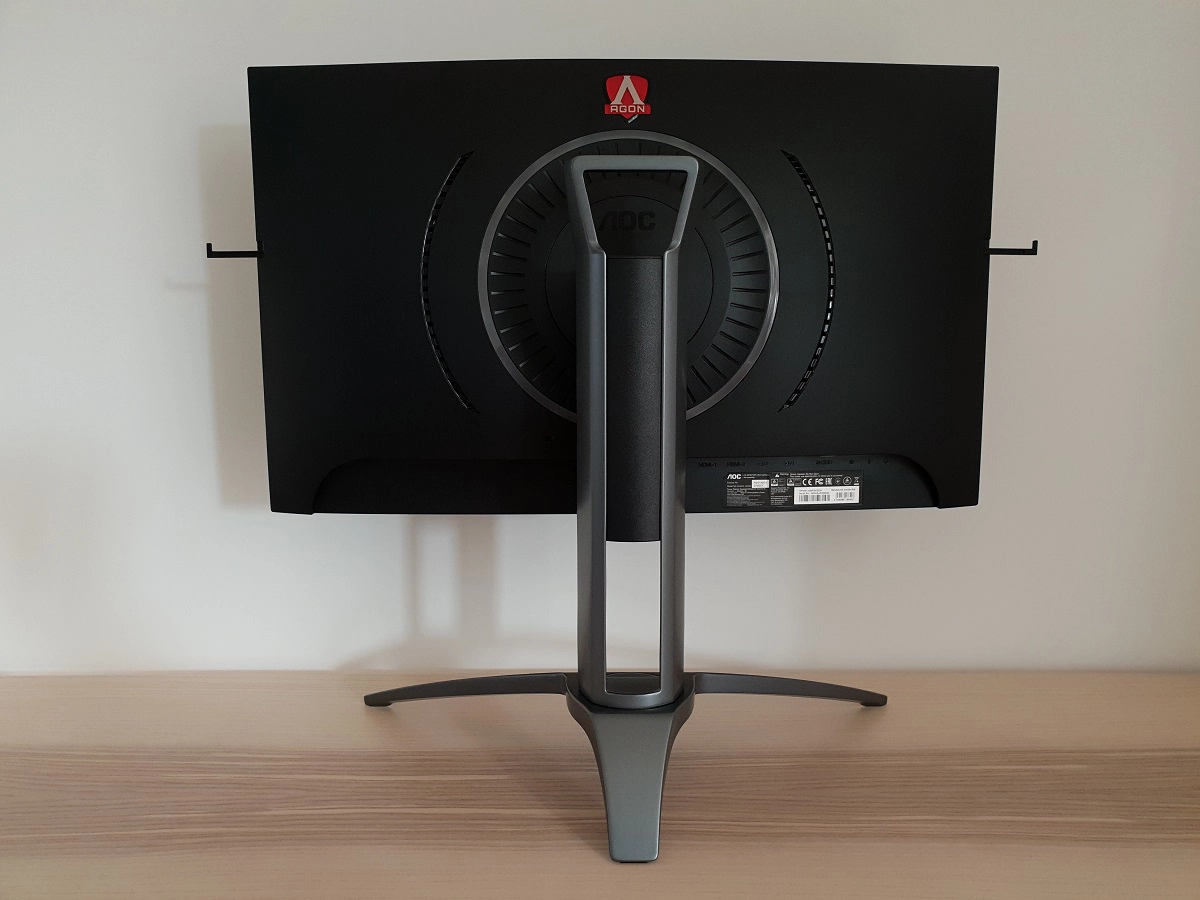
Calibration
Subpixel layout and screen surface
![]()
Testing the presets
Monitor Settings Gamma (central average) White point (kelvins) Notes Gamma1 (Factory Defaults) 1.9 6585K The monitor appears bright with some good vibrant elements, but a clear lack of depth overall due to gamma handling. As usual for a VA model there are perceived gamma changes depending on which part of the screen you’re looking at. Some saturation is lost lower down the screen and towards the sides, but this isn’t extreme for the panel type. Gamma2 1.8 6605K As above but average gamma reduced slightly, sapping a bit of depth in places. Gamma3 2.2 6606K As factory defaults with significantly higher gamma. Things now appear deeper and fuller with a vibrant and saturated look. The overall colour balance is good, with the white point just slightly higher than the target and no green tint. LowBlue Mode = Reading 1.9 5475K A moderately effective ‘Low Blue Light’ (LBL) setting. This provides a fairly significant reduction in the strength of the blue channel and lowers blue light output from the monitor. The image appears warmer than the factory defaults and a green tint is introduced. This green tint isn’t extreme - your eyes adjust to it fairly readily given some time. LowBlue Mode = Office 1.9 5865K A somewhat weaker ‘LBL’ setting, with slightly reduced green tint. LowBlue Mode = Internet 1.9 6325K As above, but a significantly weaker LBL setting with no noticeable green tint. The blue channel is weakened only slightly compared to factory defaults. LowBlue Mode = Multimedia 1.9 6440K The weakest LBL setting with only a very mild effect on blue light output or indeed the overall image. Color Temp. = sRGB 2.2 6501K This is an sRGB emulation setting. Things appear significantly less saturated than factory defaults and there is an underlying green tint. The gamma setting is locked and colour channel adjustments aren’t available. Although gamma tracking is good overall, there are some kinks in shade reproduction which significantly lightens darker shades, revealing unintended detail. Test Settings (see below) 2.2 6518K As ‘Gamma3’, but brightness set to a much more comfortable level and slight colour channel adjustments made. Image appears vibrant and strongly saturated, but varied and well-balanced in many respects.
Straight from the box the monitor outputted a fairly vibrant image in some respects, but with a noticeable lack of depth overall. This was easily remedied by changing the ‘Gamma’ setting in the OSD. Because the white point was very much where it should be on our unit, we made only a few basic tweaks to our ‘Test Settings’. The monitor then adhered quite closely to the ‘2.2’ curve as shown below. Given the intended uses of the monitor, inter-unit variation and pleasing performance following OSD tweaking alone we will not be providing any ICC profiles for this model or using them in the review. The monitor had a range of ‘LowBlue Mode’ settings. These were fairly easy to access and vary in their effectiveness. The most effective mode, ‘Reading’, was not quite as strong in its blue light reduction as we’d like but was still fairly effective. It’s a setting which we used for our own viewing comfort in the evening but not for specific testing beyond the setting itself. More specifically, we used our ‘Test Settings’ with this applied over the top – you can make further manual adjustments to colour channels with a ‘LowBlue Mode’ active if you like, potentially making it more effective. Lowering brightness as well is very helpful in cutting blue light exposure. Cutting out blue light as much as possible in the hours leading up to sleep is useful as it’s an alertness signal used by the body to keep you awake and it disrupts sleep hormones. For our ‘Test Settings’ we lowered the brightness and made a few tweaks elsewhere. Note that individual units and preferences vary, so these settings aren’t going to be optimal in all cases. Assume any setting not mentioned, including ‘Contrast’, was left at default. We performed additional testing with ‘FreeSync’ enabled in the OSD, for relevant sections of the review. Note that this setting does not impact the contrast or colour reproduction characteristics explored in the review. We’ve also included the refresh rate used in Windows and our preferred ‘Response Time’ setting, just for reference. Note that these settings only apply to SDR (Standard Dynamic Range) testing, which is the bulk of our review. HDR (High Dynamic Range) has separate settings associated with it – we explore HDR separately in the designated section. Brightness= 35 (according to preferences and lighting) Color Temp. = User Red= 50 Green= 50 Blue= 49 Overdrive= Strong OverClock Enable= On Refresh rate= 144Hz (Windows setting) A BasICColor SQUID 3 (X-Rite i1Display Pro) was used to measure the luminance of white and black using a range of monitor settings, including those analysed in the calibration section. From these values, static contrast ratios were calculated. Results are show in the table below. Blue highlights indicate the results under our ‘Test Settings’ and with HDR active. Black highlights indicate the highest white luminance, lowest black luminance and highest contrast ratio recorded (HDR and MBR deactivated). Assume any setting not mentioned was left at default, with the exceptions already noted here or in the calibration section.
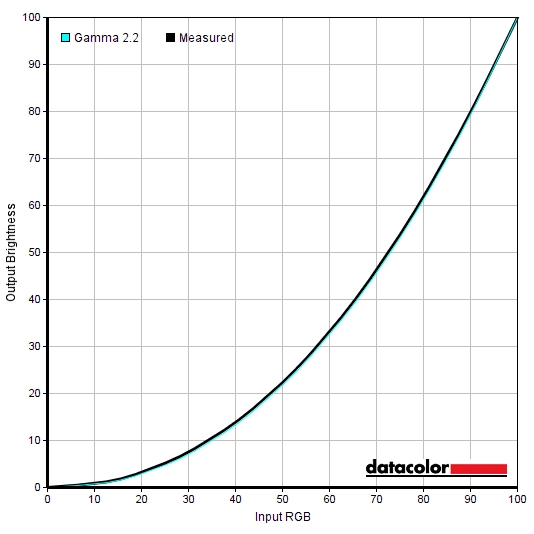
Gamma 'Test Settings'
Test Settings
Game Mode= Off
Contrast and brightness
Contrast ratios
Monitor Settings White luminance (cd/m²) Black luminance (cd/m²) Contrast ratio (x:1) 100% brightness 423 0.13 3254 80% brightness 268 0.09 2978 60% brightness 226 0.07 3229 40% brightness 173 0.06 2883 20% brightness 125 0.04 3125 0% brightness 77 >0.02 <3850 Gamma1 (90% brightness, Factory Defaults) 294 0.09 3267 Gamma2 294 0.09 3267 Gamma3 294 0.09 3267 HDR* 483 0.15 3220 HDR Picture* 482 0.15 3213 HDR Movie* 482 0.15 3213 HDR Game* 480 0.15 3200 Low Blue Mode = Reading 285 0.09 3167 Low Blue Mode = Office 288 0.09 3200 Low Blue Mode = Internet 291 0.09 3233 Low Blue Mode = Multimedia 292 0.09 3244 Color Temp. = sRGB 285 0.09 3167 MBR = 1 @120Hz 317 0.10 3170 MBR = 1 @144Hz 315 0.10 3150 MBR = 15 @120Hz 166 0.05 3320 MBR = 15 @144Hz 165 0.05 3300 MBR = 20 @120Hz 115 0.04 2875 MBR = 20 @144Hz 115 0.04 2875 Test Settings 162 0.05 3240
*HDR measurements were made using this YouTube HDR brightness test video, running full screen at ‘1440p HDR’ on Google Chrome. The maximum reading from the smallest patch size (measurement area) that comfortably covered the entire sensor area and colorimeter housing was used for the white luminance measurement, which was ‘4% of all pixels’ in this case. The black luminance was taken at the same point of the video with the colorimeter offset to the side of the white test patch, equidistant between the test patch and edge of the monitor bezel.
The average static contrast with only brightness adjusted was 3094:1, which is strong. This excludes the reading at ‘0’ brightness, as the rounding of the black point throws off the accuracy of this reading too much. The refresh rate didn’t influence the contrast. Following adjustments made to our ‘Test Settings’, we recorded a static contrast ratio of 3240:1 which is pleasing. Strong contrast was maintained regardless of settings used, including any ‘Low Blue Mode’ settings, the ‘sRGB’ emulation mode or ‘MBR’ being active. The highest white luminance recorded under SDR was 423 cd/m² which is fairly bright, whilst the minimum white luminance recorded without loss of contrast was 77 cd/m². This is somewhat brighter than sensitive users would like, but should be fine for most users.
Activating HDR did nothing to enhance contrast. This wasn’t at all unexpected given that it only VESA DisplayHDR 400 certified (as explored later) and lacks any sort of local dimming on the backlight. We tested various presets with HDR active and none yielded any enhancement to contrast, with a significant enhancement there requiring local dimming for the backlight and therefore physically impossible on this model. The peak luminance was raised to 483 cd/m² under HDR, though, which is quite bright (although not outstanding by HDR standards). The monitor also includes a Dynamic Contrast setting called ‘DCR’ (Dynamic Contrast Ratio). This allows the backlight brightness to adjust according to the level of light or dark being displayed. As we’ve established, though, there’s no local dimming so this setting is a compromise at best. It’s quite reactive to changes in scene luminance and dims fairly effectively for predominantly dark content. But tends towards a higher brightness than we’d like for mixed content. We prefer manual control of brightness where local dimming is lacking.
PWM (Pulse Width Modulation)
The monitor uses DC (Direct Current) to dim the backlight and does not use PWM (Pulse Width Modulation) under any brightness setting. The backlight is therefore considered ‘flicker-free’, which will be welcomed by users who are sensitive to flickering or worried about the side-effects of PWM usage. The exception to this is with MBR (Motion Blur Reduction) active, as this is a strobe backlight function which causes flickering at a frequency matching the refresh rate of the display.
Luminance uniformity
Whilst observing a black background in a dark room, using our ‘Test Settings’, we noticed some backlight bleed and clouding at the top and bottom of the screen. It’s important to remember that individual units vary when it comes to all aspects of uniformity, including backlight bleed. This is shown in the image below, taken a sufficient distance back to eliminate ‘VA glow’. This is a silverish or purple glow, depending on angle, that’s visible towards the bottom of the screen in particular from a normal viewing position. It blooms out and becomes more noticeable as viewing angle is increased, as demonstrated in a video later. The luminance uniformity was good overall. The maximum luminance was recorded at ‘quadrant 5’ in the centre of the screen (151.8 cd/m²). The greatest deviation from this occurred at ‘quadrant 9’ towards the bottom right of the screen (132.8 cd/m², which is 13% dimmer). The average deviation between each quadrant and the brightest recorded point was 5.75%, which is quite pleasing. Note that individual units vary when it comes to uniformity and you can expect further deviation beyond the points measured. Also note that there are some perceived brightness shifts due to VA viewing angle limitations that aren’t accounted for by colorimeter measurements. The contour map below shows these deviations graphically, with darker greys representing lower luminance (greater deviation from brightest point) than lighter greys. The percentage deviation between each quadrant and the brightest point recorded is also given. The Spyder5ELITE was also used to analyse variation in the colour temperature (white point) for the same 9 quadrants. The deviation between each quadrant and the quadrant closest to the 6500K (D65) daylight white point target was analysed and a DeltaE value assigned. A DeltaE <3 represents deviation that most users wouldn’t readily notice by eye. Results here were good, with no significant deviations recorded. There were some patches of relative weakness (warmer colour temperature), particularly centrally, but the deviation recorded was not significant. Note again that individual units vary when it comes this and other aspects of uniformity and that you can expect deviation beyond the measured points. The VA panel also brings with it perceived deviations in colour temperature which aren’t accounted for by these measurements. Indeed, we did observe a noticeably cooler look to white and light greys towards the flanks of the screen which was most intense when viewing from a relatively close viewing position (<60cm). In addition to the quantitative testing above, we performed a subjective assessment of the uniformity of a variety of other shades, including 5% (dark) grey, 35% (medium-dark) grey and 50% (medium) grey. Some monitors exhibit clear uniformity issues such as splotches or striations when viewing screen fills of such shades, giving an inconsistent appearance that some users refer to as ‘DSE’ (‘Dirty Screen Effect’). VA models are particularly prone to this, with this being a common complaint on the Samsung C27HG70 for example. We didn’t observe anything particularly troubling on our AG273QCX sample. There weren’t distinct striations or an obvious blotchy appearance of some of the worst offenders. There was a little patchiness in places with some noticeable shifts in colour temperature that weren’t accounted for by viewing angle weakness. This is shown in the image below, with a medium grey screen fill taken from a central position a sufficient distance back to eliminate viewing angle influences. As above, note that uniformity varies between individual units. The monitor provided a strong contrast performance overall on Battlefield V. When observing darker scenes, the depth to the dark shades and general atmosphere created was clearly superior to on non-VA LCDs. If viewing in a dark room, there wasn’t the sort of inky depth you might get on a model with much stronger contrast (such as an OLED or a model with highly effective local dimming on the backlight). But in any lighting conditions there was clear relative strength compared to TN and IPS models. There was a degree of ‘VA glow’ observable from a normal viewing position, lightening some of the dark shades and creating a slight bloom lower down the screen. This was not extreme, though, less noticeable than on the Samsung C27HG70 for example. We also observed some loss of detail for dark shades due to ‘black crush’. This is whereby some of the darkest shades (close to black) in the central region of the screen appear even darker than intended when viewed from a normal viewing position, so they blend into a black mass. This masks some detail, whereas observing these shades closer to the edges of the screen reveals a more appropriate level of detail. And viewing from a sharper viewing angle (‘off-angle’) reveals unintended detail. This black crush was not extreme for a VA model and is something all VA models have to some degree – the somewhat blended appearance it gives to such scenes is usually preferred compared to some models which reveal unintended details (‘banding’ or a ‘blocky appearance’). Brighter shades stood out very nicely against darker surroundings. They had a slight misty graininess from the screen surface, but no heavy or ‘smeary’ or layered graininess. The monitor also provided a strong contrast performance on Shadow of the Tomb Raider. With its abundance of dark tombs (the clue is in the name), caves and dimly lit passageways, there were plenty of dark areas to explore on this title. The AG273QCX presented things in a significantly deeper and more atmospheric way than you’d see on your typical (SDR) TN or IPS model, for the central mass of the screen at least. There was again a degree of ‘VA glow’ towards the bottom of the screen, but nothing extreme from a normal viewing position. And some ‘black crush’ which masked some detail. The level of detail masking from the black crush was not as significant as the level of detail loss you’d see higher up on a TN model of this size (due to perceived gamma shifts there). You could more clearly see porous rock textures even in quite dimly lit scenes, so you know they’re climbable, compared to higher up on a 27” TN model. The screen surface again imparted some graininess, but this was light and misty rather than heavy and ‘smeary’. Brighter shades such as flames and gunfire lit up darker surroundings nicely and stood out with good ‘pop’ due to the relatively strong contrast. The monitor also provided pleasing contrast for the film Star Wars: The Last Jedi. This title has plenty of scenes that demand a cinematic and high-contrast look, such as battles or dark interior locations lit only by flames, light sabers and a few dim lights. The monitor gave a good atmospheric look to these sorts of scenes, with the brighter elements standing out very nicely. The ‘black crush’ and ‘VA glow’ were of course still there, but neither really took too much away from the overall atmosphere of the film. When compared to the relative detail changes due to TN gamma shifts, for example. We didn’t observe issues with excessive detail levels in dark scenes, which can lead to a ‘blocky’ or ‘banded’ appearance. The gamma tracking of the monitor and overall shade reduction characteristics were not problematic in that respect. The Lagom tests for contrast allow specific weaknesses in contrast performance to be identified. The following observations were made. The colour gamut of the AG273QCX (red triangle) is compared with the sRGB (green triangle) and Adobe RGB (purple triangle) colour spaces in the image below. The monitor comprehensively covers the sRGB colour space (100%) with moderate extension beyond this. The monitor does not extend anywhere near as far as Adobe RGB in the green corner of the gamut, but extends a bit beyond in the red to blue region (85% Adobe RGB). Note that Adobe RGB overlaps sRGB on the red and blue corners of this representation. The monitor has a specified 90% DCI-P3 colour gamut, which is in-line with the near-term target for HDR and specifically the HDR10 standard. Our colorimeter software doesn’t support comparison with DCI-P3, but the gamut does appear to be in-line with the specified value. Also be aware that the Spyder5 tends to slightly under-report the blue region of the gamut for models with a colour gamut this wide. The colour gamut of this model gives the monitor the potential to output all shades within the sRGB colour space, with some extra vibrancy and saturation. On Battlefield V the monitor provided a spectrum of lively-looking colours. The fairly extensive colour gamut lifted the saturation level of many shades, giving a vibrant appearance overall. This was not the same as the effect you’d get raising digital saturation (e.g. Nvidia Digital Vibrance or increasing ‘Game Color’ in the OSD) as appropriate spacing between shades is maintained on the gamut and they aren’t simply pulled closer to the edge of the gamut without any expansion of the gamut itself. It isn’t the same as the skewed and cartoonish representation that more traditional wide gamuts (Adobe RGB) provide, with extreme extension in the green region of the gamut but sRGB-like tracking elsewhere. There were some eye-catching and very lush-looking green shades alongside some more muted dusty khaki shades. These dusty shades appeared muted relative to the more vibrant, deep and lush greens but didn’t appear as muted as they ideally. Earthy browns also maintained a nice palette with some nice rich-looking shades alongside more muted ones, although the reddish hue was somewhat stronger than it should be in places. Vibrant elements such as fires and brightly painted objects showcased some very nice vivid-looking oranges, reds, purples and greens. There were some saturation losses and some shades appeared slightly ‘duller’ towards the extreme edges and bottom of the screen. These shifts were minor from a normal viewing position (eyes 70cm+ from the screen, sitting fairly square onto the screen) and as low as you’ll see on a VA model. They became more pronounced if you moved your head far enough off-angle or viewed the screen from closer up. On Shadow of the Tomb Raider similar colour reproduction characteristics were apparent. Things again appeared quite rich overall, less so further down the screen but still far from ‘washed out’ in our view. There were some nice lush forest green shades, good rich earthy browns and fairly (but not excessively) vivid sky blues for shown for the central mass of the screen. Lara’s skin tone is something we’ve become almost obsessed with when testing monitors. And it’s quite a nice way of encapsulating colour consistency issues with monitors. She looked more or less as she should for the central mass of the screen, but her skin did appear too pale lower down the screen. Above the central region she received a ‘healthy tan’, becoming quite overdone near the top. These shifts are quite typical for TN models, but were again less pronounced than on some high refresh rate Full HD TN models. We also made observations using the Blu-ray of Futurama: Into the Wild Green Yonder. This is a brutally unforgiving test for colour consistency, with many large areas of individual shade which will clearly highlight any inconsistencies. The monitor performed well in that respect, overall, and certainly as well as we’ve seen from a VA model. There was some loss of saturation and a somewhat ‘duller’ look to some shades at the extreme edges and bottom of the screen, but the shifts were minor compared to any TN model and some VA models. This sort of thing meant the monitor couldn’t reproduce the same sort of subtle distinctions between shades like character skin tones in the way an IPS model could. But there was still a pleasing variety of muted pastel shades, appearing somewhat livelier than they should due to the colour gamut but still appearing muted relative to other shads. There were also some impressively eye-catching neon shades and deep shades such as purples and bright greens. These were most eye-catching when combined with a darker background shade, with the strong contrast and colour gamut combining to help them really stand out. Lagom’s tests for viewing angle tests were used to further explore colour consistency and viewing angle performance. The following observations were made from a normal viewing position, eyes around 70cm from the screen. On some monitors, particularly but not exclusively those with high refresh rates, interlace patterns can be seen during certain transitions. We refer to these as ‘interlace pattern artifacts’ but some users refer to them as ‘inversion artifacts’ and others as ‘scan lines’. They may appear as an interference pattern or mesh or interlaced lines which break up a given shade into a darker and lighter version of what is intended. They often catch the eye due to their dynamic nature, on models where they manifest themselves in this way. Alternatively, static interlace patterns may be seen with some shades appearing as faint horizontal or vertical bands of a slightly lighter and slightly darker version of the intended shade. We did not observe any dynamic ‘interlace pattern artifacts’, although we did observe some static interlace patterns in places. This included but was not limited to certain medium-light greys, various blue shades and dark browns. They broke up into horizontal lines of a slightly lighter and darker variant of the intended shade in places. This static interlacing was reasonably faint and not everybody will notice it or find it bothersome, although sensitive users such as us can find them quite noticeable at times. We don’t find them as eye-catching as ‘dynamic interlace patterns’, which are particularly difficult to ignore if you’re sensitive to them. We used a small tool called SMTT 2.0 and a sensitive camera to compare the AG273QCX’s latency with a screen of known latency. To help maximise accuracy, over 30 repeat readings were taken. Using this method, we measured 6.15ms (a little under 1 frame @144Hz) of input lag. There was no measurable difference with ‘Low Input Lag’ enabled in the OSD vs. ‘FreeSync’ set to ‘On’ in the OSD. This value is influenced both by the element of input lag you ‘feel’ (signal delay) and the element you ‘see’ (pixel responsiveness). It indicates a fairly low signal delay which shouldn’t bother most users. Unfortunately, we don’t have the means to accurately measure input lag with FreeSync active in a variable refresh rate environment or with HDR active in an HDR environment. In our article on responsiveness, we explore some of the key concepts related to the topic. One of these very important concepts is known as perceived blur. This is contributed to not only by the pixel responsiveness of the monitor, but also the movement of your eyes as you track movement on this screen. This second factor is actually the key cause of perceived blur on modern monitors, but pixel responses still play an important role. We also introduce a photography technique called ‘pursuit photography’, which uses a moving camera to capture motion on a monitor in a way that reflects both the pixel responsiveness and eye (camera) movement. This contrasts with static photographs or videos which only represent the pixel response element of perceived blur. The images below are pursuit photographs taken using the UFO Motion Test for ghosting. The test is set to run at its default speed of 960 pixels per second, which is a practical speed for such photographs and sufficient to help highlight key weaknesses. The monitor was tested at 60Hz (directly below), 120Hz and 144Hz with all of the main ‘Overdrive’ settings; ‘Off’, ‘Weak’, ‘Medium’ and ‘Strong’. The ‘Boost’ setting is separate as it is simply a toggle that quickly enables MBR (Motion Blur Reduction) at the maximum level – we explore MBR a little later. Note that you need to have ‘Low Input Lag’ set to ‘On’ in the ‘Game Setting’ section of the OSD or be using FreeSync on an AMD GPU for the ‘Overdrive’ settings to behave properly, as we show below. Otherwise (and this includes using Adaptive-Sync on an Nvidia GPU) it sticks to ‘Off’ regardless of what you select. All rows of the UFO Motion Test were used, to show a range of pixel transitions between various shades. The final columns show two references for comparison, where possible. A Samsung C27HG70 which is a direct competitor to this model and the ViewSonic XG240R which shows how things look where pixel responses aren’t really a limiting factor. At 60Hz, shown above, the UFO appears soft and unfocused. This reflects a moderate amount of perceived blur due to eye (camera) movement – an element shared with the reference screens. There are also various degrees of trailing behind the object, highlighting some weaknesses with pixel responsiveness. With ‘Overdrive = Off’ there is an extended ‘smeary’ trail for the dark background (top row), some lighter ‘powdery’ trailing for the medium background (middle row) and only a faint hint of trailing for the light background (bottom row). The ‘Weak’ setting cuts back on the trailing for the dark background and medium background, although introduces a little overshoot (inverse ghosting). You can see this as a slight ‘dirty’ (dark) trail behind the UFO cockpit for the medium background and a slight bright (‘halo’) trail behind the UFO for the light background. The ‘Medium’ setting intensifies this overshoot significantly, making it quite colourful. For the dark background the ‘smeary’ trail persists. The ‘Strong’ setting ramps things up further, strengthening the overshoot. The ‘smeary’ trailing persists for the dark background but appears dirty due to overshoot being mixed in. Note the difference with the C27HG70 reference for this background (bright overshoot, no ‘smeary’ appearance), with the medium and light background appearing similar to the AG273QCX using the ‘Strong’ setting. The XG240R reference is very clean without such distinct weaknesses. We’d consider the ‘Weak’ setting optimal at 60Hz, although individual preferences differ. The following image shows how things look with the refresh rate bumped up to 120Hz. At 120Hz, shown above, the UFO is significantly narrower with sharper focus. This reflects a significant decrease in perceived blur due to eye movement. There is again varying degrees of trailing behind the object, although the differences between the ‘Overdrive’ settings aren’t as clear. There is a gradual weakening of the trailing, with the ‘Strong’ setting showing the best results. With this setting, there remains some ‘smeary’ trailing for the dark background (but somewhat less than with weaker settings), some ‘powdery’ trailing for the medium background and a little overshoot and some light ‘powdery’ trailing plus a bit of overshoot for the light background. We consider ‘Strong’ to be the optimal setting here. The image below shows what things look like with a slight bump up in refresh rate to 144Hz. At 144Hz, above, the UFO appears slightly narrower and more sharply focused. Obviously not as significant a difference as comparing 60Hz to 120Hz, but still an improvement. This reflects slightly lower perceived blur due to eye movement. The trailing behind the object is fairly similar to at 120Hz. Because the perceived blur due to eye movement is decreased (object is narrower) and the refresh rate itself has increased, the pixel response requirements for a ‘clean’ performance also increase slightly. The trailing is therefore slightly more extended, although the overall nature of the trailing is quite similar. Most users will appreciate the improved ‘connected feel’ (explored later) and the overall reduction in perceived blur at 144Hz regardless of this. The ‘Strong’ setting is again optimal, without strong overshoot for the transitions shown here and a slight reduction in trailing compared to weaker settings. The C27HG70 reference almost looks like another step up in overdrive over the AG273QCX, with a bit more of a reduction in trailing without any obvious overshoot being introduced for these transitions. The XG240R reference is very clean indeed, the envy of pretty much any other LCD on the market. Whilst increasing refresh rate clearly reduces perceived blur due to eye movement, for users who want to minimise this as much as possible the monitor has another setting of interest. MBR (Motion Blur Reduction), which is a strobe backlight feature that can be used if ‘FreeSync’ is disabled. This massively reduced eye movement (and hence perceived blur) by causing the backlight to flicker at a frequency matching the refresh rate of the display – either 120Hz or 144Hz. Individual sensitivity to this flickering varies. Some users may notice accelerated eye fatigue when using this setting even if they aren’t actively noticing any flickering. The MBR setting can be adjusted between ‘1’ and ‘20’ in single unit increments – we explore what this means very shortly. The images below show the monitor with MBR set to various settings at 120Hz (directly below) and 144Hz. A range of reference screens are shown with the medium background used, either a Dell S2417DG (120Hz) or AOC AG251FG (144Hz) with their ULMB (‘Ultra Low Motion Blur’) strobe backlight setting active. And an AOC C24G1 with MBR active, set to our preferred settings for that model (‘MBR = 10’ and ‘Overdrive = Strong’). Before analysing the image above, it’s important to note that the ‘Overdrive’ was set to ‘Strong’ for all pursuit photographs showing the MBR setting in action. Anything lower than this made the trailing too bold and essentially caused some widespread trailing that was appeared as an extension of the object itself rather than a fainter repetition. This duplication of objects with MBR active was quite uncomfortable to look at and made the overall perceived blur reduction less impressive. This image is a pursuit photograph taken at 144Hz with ‘MBR = 15’ and ‘Overdrive = Medium’ so you can see what we’re referring to. With MBR enabled, at 120Hz (above), you can see that the object itself appears sharper and more detailed than with the technology disabled (regardless of refresh rate). The fine details on the UFO becoming increasingly well-defined as the MBR setting is raised. The MBR values correspond (inversely) to the ‘Pulse Width’. A setting of ‘1’ uses the longest ‘Pulse Width’, meaning that the backlight stays on for a relatively long period during the strobe cycle. This increases brightness at the expense of motion clarity. A setting of ‘20’ indicates the shortest ‘Pulse Width’, decreasing brightness but giving the highest level of motion clarity. We found the setting of ‘MBR = 15’ provided a comfortable balance between clarity and brightness, but the single unit increments allow good flexibility according to individual preferences. You can see a fair amount of trailing behind the UFOs regardless of the setting used, due to slower than optimal pixel responses. The ‘smeary’ trailing observed earlier for the dark background is very much alive here, with a fair degree of trailing for the medium background and relatively trailing for the light background. By comparison, the S2417DG shows no conventional trailing but instead has some overshoot. The C24G1, meanwhile, shows fainter trailing (plus a little overshoot) when compared to the medium background of the AG273. The image below shows how things look at 144Hz. At 144Hz with MBR (above) things look quite similar overall. There appears to be a slight increase in clarity for the ‘MBR = 15’ setting, although the differences there could be accounted for by how the camera took the images. There are some slight changes to the trailing behind the UFO, but nothing major. What’s more noticeable, really, is the increase in ‘connected feel’ this slight step up provides and some users will appreciate the decreased. The AG251FG reference again shows overshoot rather than conventional trailing, but superb clarity for the object itself. The C24G1 reference shows less bold trailing than the medium background on the AG273. Another thing you may notice in the above images is that there is sometimes what appears to be trailing in front of the UFO as well, particularly for the dark background. This is ‘Strobe Crosstalk’, which occurs due to the pixel responses not keeping up with the rigorous demands of the refresh cycle. You can see this behind the UFO in places as well, it can be used as a general term to describe trailing observed with a strobe backlight setting active. Because not all parts of the screen refresh simultaneously, the appearance of strobe crosstalk varies at different parts of the screen. This is shown in the below image, which shows pursuit photographs running from the top to bottom of the screen. The monitor was running at 144Hz with ‘MBR = 15’ for this image, as it was our favoured setting overall. Further up the screen, you can see the strobe crosstalk appearing in front of the object. This explains why the dark background showed this most clearly in the main testing above – it was higher up the screen. Centrally the strobe crosstalk is not visible as things are well optimised here in terms of strobe timing. Further down the screen the strobe crosstalk appears behind the object instead. It is important that the centre of the screen is well optimised, as is the case here, because that is the area of the screen you’ll mainly focus on when gaming. And when focusing on a game you tend to find strobe crosstalk in general less visible. The image below shows the strobe crosstalk at various points of the screen with ‘MBR = 20’. The strobe crosstalk is visible near the top, in front of the object, but fades away more quickly so that a larger area of the screen is well optimised. Further down the screen the strongest strobe crosstalk behind the object (where it appears duplicated rather than having a fainter trail behind it) starts at a similar point to ‘MBR = 15’. Most users will likely find these differences in strobe crosstalk difficult to notice in practice and should really consider the brightness and overall clarity balance before this. On Battlefield V the 144Hz refresh rate delivered some clear advantages, where the frame rate kept pace. The ‘connected feel’ was vastly improved compared to running at a significantly lower refresh rate. With the monitor displaying up to 2.4 times as much information every second as a 60Hz monitor (at 60fps), the precision and fluidity as you interact with your character and the game environment is noticeably better. The fairly low input lag also helped in this respect. This combination of high frame rate and refresh rate also significantly decreased overall perceived blur, making it easier to track and engage enemies and giving a competitive advantage on games like this. There were some weaknesses in pixel responsiveness that added to perceived blur, however. When considering most transitions between medium and lighter shades (running around on a bright map, for example, such transitions are common) there was a degree of ‘powdery trailing’ in places. This was generally light and just added a whiff of extra perceived blur, so not hugely detrimental to gameplay. There were some examples of ‘heavy powdery trailing’ as well, which had a more significant impact on perceived and stood out more clearly against amongst faster transitions. There was some overshoot for some transitions as well – partially transparent trails and some ‘shadowy’ trailing that was darker than the object or background colour. But nothing extreme. The real Achilles heel of VA models like this, though, are the transitions involving darker shades. This includes so-called ‘high contrast transitions’ between bright and significantly darker shades, but also mixtures of very dark and medium-dark shades moving against one another. There were some standout weaknesses on this model where these transitions were concerned, even using our preferred ‘Strong’ setting for ‘Overdrive’. There were instances of significantly slower than optimal pixel transitions, giving a ‘smeary’ trailing in places. This often contained an element of ‘break-up’ trailing whereby some shades would leach out during the transition. The dark military uniform of a solider at night against the sky, for example, might have some of the dark brown or green shades leaching out as ‘break-up’ trailing. The section of the video below gives some examples of this and also looks and some of the faster transitions on this model. As noted, many transitions are enough to avoid these distinct stand-out weaknesses. But some persist and that could annoy some users. Finally, we made some observations on movie content at a variety of frame rates. There were some weaknesses in places, but these were less distinct than the significantly higher frame rate game content. For the ~24 – 30fps content there were no real standout weaknesses. Some traces of ‘break-up’ trailing in places but this didn’t extend far behind the object that’s moving and wasn’t really distracting. The frame rate of the content itself greatly limited fluidity and indeed the pixel response requirements for good performance. The higher frame rate content (50fps) highlighted some slightly more extended ‘break-up’ trailing, some ‘smeary trailing’ and some ‘powdery’ trailing in places. This was less distinct than at significantly higher frame rates and didn’t really mar our enjoyment of these titles. AMD FreeSync is a variable refresh rate technology, an AMD-specific alternative to Nvidia G-SYNC. With this technology, the monitor adjusts its refresh rate dynamically, where possible, to match the frame rate being outputted by the GPU. Both the responsiveness article and the G-SYNC article linked to previously explore the importance of these two elements being synchronised. Essentially, a mismatch between the frame rate and refresh rate can cause stuttering (VSync on) or tearing and juddering (VSync off). An additional benefit of FreeSync is reduced latency compared to running with VSync on, within the variable frame rate environment in which it operates. FreeSync requires a compatible AMD GPU such as the Radeon RX 580 used in our test system. There is a list of GPUs which support the technology here, with the expectation that future AMD GPUs will also support the feature. The monitor itself must support ‘VESA Adaptive-Sync’ for at least one of its display connectors, as this is the protocol that FreeSync uses. The AG273QCX supports FreeSync via DP and HDMI on compatible GPUs and systems. More specifically, ‘FreeSync 2’ is supported by the monitor, encompassing HDR support (this feature is not AMD-specific) and a relatively generous effective range of operation. HDR can be activated (at the same time as FreeSync) via DP 1.4 or HDMI 2.0. If fully installed, AMD drivers feature Radeon Settings, which makes activation of the technology very simple and something that usually occurs automatically. First make sure that you have ‘FreeSync’ set to ‘On’ in the ‘Game Setting’ section of the OSD. You should then make sure the GPU driver is setup correctly to use FreeSync, so open ‘AMD Radeon Settings’ and click on ‘Display’. You should then ensure that the first slider, ‘AMD FreeSync’, is set to ‘On’. If you hover over this, it will also report the variable refresh rate display supported by the display. VSync is configured in the ‘Gaming’ section of ‘Radeon Settings’, where it is referred to as ‘Wait for Vertical Refresh’. You can either configure this globally under ‘Global Settings’ or for each game individually. The default is ‘Off, unless application specifies’ which means that VSync will only be active if you enable it within the game itself, if there is such an option. Such an option does usually exist – it may be called ‘sync every frame’ or something along those lines rather than simply ‘VSync’. Most users will probably wish to enable VSync when using FreeSync to ensure that they don’t get any tearing. You’d therefore select either the third or fourth option in the list, shown in the image below. The final option, ‘Enhanced Sync’, is a relatively new addition to the driver. This is an alternative to VSync which allows the frame rate to rise above the refresh rate (no VSync latency penalty) whilst potentially keeping the experience free from tearing or juddering. This requires that the frame rate comfortably exceeds the refresh rate, not just peaks slightly above it. We won’t be going into this in detail as it’s a GPU feature than a monitor feature. We tested various game titles with FreeSync active on the monitor and found the experience to be very similar on all of them, at a given refresh rate. Any issues identified on one title but not another would indicate an issue with the game or GPU driver rather than a monitor issue. So instead of focusing on various titles and repeating observations, we’ll simply be focusing on Battlefield V for this section. This title offers appropriate graphical flexibility to allow the full range of refresh rates to be observed with FreeSync active. With our lowly Radeon RX 580, it certainly wasn’t easy to maintain a constant 144fps, even on single player without particularly intense action on screen. Using rather modest graphics settings, we were able to achieve decent triple digit frame rates. Without FreeSync active, there was obvious stuttering (VSync enabled) or tearing (VSync enabled) from frame rate and refresh rate mismatches. Individual sensitivity to this varies, but as we’re sensitive to this it was a massive relief having these nuisances removed. We did prefer the higher frame rates (ideally 144fps or as close as possible) vs. lower frame rates (~100fps) in this observation range. That’s because higher frame rates still lower perceived blur and improve ‘connected feel’, the frame rate itself is still important. With graphics settings turned up further, we observed further drops in frame rate. As triple digits became a distant memory and the frame rate dropped well below 100fps, the difference in ‘connected feel’ and increase in perceived blur was painfully obvious to us. However; it was still very welcome having the tearing and stuttering from frame and refresh rate mismatches removed. We also noticed an increase in overshoot (inverse ghosting) as the frame rate dipped and therefore the refresh rate also dipped. This is something we commonly observe on FreeSync monitors and it’s something that G-SYNC models generally handle a lot better. Nvidia uses something called ‘variable overdrive’ which slackens off the aggressiveness of the pixel overdrive appropriately as refresh rate reduces. FreeSync monitors tend to be tuned with their highest native refresh rate in mind, in this case 144Hz. The issue is tied to the pixel response behaviour at different refresh rates rather than frame rates, so you don’t observe this increased overshoot with FreeSync disabled and running the monitor at a static 144Hz. Having said that, the overshoot was not extreme and not as widespread or as ‘in your face’ as on some FreeSync models at similar refresh rates. Nor was it as obvious as at a static 60Hz refresh rate. And if you’re particularly sensitive to overshoot and are commonly at these low frame rates, you could slacken off the ‘Overdrive’ to ‘Weak’. This increases conventional trailing, making powdery trailing more widespread, but some users may prefer this to the overshoot. Where frame rate dipped below the floor of operation (48fps – 48Hz), the monitor employed LFC to keep the refresh rate at a multiple of the refresh rate. This worked very effectively to remove tearing and stuttering from less clean divisions of refresh rate and frame rate. And in some respects, it was nice when LFC kicked in as the overshoot levels reduced (it’s more noticeable at 48fps/48Hz than 49fps/98Hz). These very low frame rates certainly didn’t appeal to us, though, due to the significant increase in perceived blur and complete lack of ‘connected feel’ compared to much higher frame rates. Another perhaps smaller issue is that, when LFC activates or deactivates, there is momentary stuttering. If you’re frequently going above and below the LFC boundary this could become jarring, but it’s not extreme stuttering and doesn’t last long if you’re just passing this point occasionally. A final but important point is that we observed some flickering at times. This generally occurred where there were significant and sudden fluctuations in frame rate, of perhaps 40fps or more. The screen would flicker for about a second or two before things stabilised. There was also flickering during some very low frame rate content, such as in the menus of some games. Some flickering during significant frame drops and during very low frame rate action (or lack of) is actually quite common on VA models with variable refresh rate technology. They’re quite sensitive to the voltage changes that occur as refresh rate fluctuates. We felt this was somewhat more widespread on this model than usual, though. We also observed some instances of flickering where the frame rate was more stable and also higher. It was difficult to pinpoint exactly what caused this and it wasn’t particularly common or something we found bothersome. The same can’t be said for the flickering we observed with Adaptive-Sync on our Nvidia GPU, which we cover below. As noted earlier, AMD FreeSync makes use of Adaptive-Sync technology on a compatible monitor. As of driver version 417.71, users with Nvidia GPUs (GTX 10 series and newer) and Windows 10 can also make use of this Variable Refresh Rate (VRR) technology. When a monitor is used in this way, it is something which Nvidia refers to as ‘G-SYNC Compatible’. Some models are specifically validated as G-SYNC compatible, which means they have been specifically tested by Nvidia and pass specific quality checks. With the AG273QCX, you need to connect the monitor up via DisplayPort and enable ‘FreeSync’ in the ‘Game Settings’ section of the OSD. When you open up Nvidia Control Panel, you should then see ‘Set up G-SYNC’ listed in the ‘Display’ section. Ensure the ‘Enable G-SYNC, G-SYNC Compatible’ checkbox and ‘Enable settings for the selected display model’ is checked as shown below. Press OK, then turn the monitor off then on again so that it re-establishes connection – the technology should now be active. 1) The floor of operation for VRR was 60Hz (60fps) rather than 48Hz (48fps). Or 55Hz (55fps) if you’ve set the monitor to 120Hz. As above, an LFC-like technology was available. 2) The ‘Overdrive’ setting did not function with Adaptive-Sync enabled on our Nvidia GPU. All settings behaved as ‘Off’. 3) There was widespread flickering. As with FreeSync, this occurred during significant drops in frame rate and in some in-game menus. But there were widespread instances of flickering where frame rate was much more stable. And this included high frame rates well into the triple digits and approaching the ceiling of operation (144fps). It was most noticeable at high brightness levels or when viewing in dimmer lighting conditions – having HDR active made it particularly eye-catching. But some users would notice this at much lower brightness settings, too. This section of the video review shows the flickering effect. Our suggestions regarding use of VSync also apply, but obviously you’re using Nvidia Control Panel rather than Radeon Settings to control this. The setting is found in ‘Manage 3D settings’ under ‘Vertical sync’, where the final option (‘Fast’) is equivalent to AMD’s ‘Enhanced Sync’ setting. You’ll also notice ‘G-SYNC Compatible’ listed under ‘Monitor Technology’ in this section, as shown below. Make sure this is selected (it should be if you’ve set everything up correctly in ‘Set up G-SYNC’). We’ve already introduced the MBR (Motion Blur Reduction) feature, its principles of operation and how it performs using specific tests. We’ve also explained that our preferred settings to use with this feature are a 144Hz refresh rate with ‘Overdrive = Strong’ and ‘MBR = 15’. When using MBR or any strobe backlight feature, it’s very important that your frame rate matches the refresh rate you’re running at. Otherwise you are greeted with extremely obvious stuttering or juddering, which stands out due to there being very little perceived blur to mask it. FreeSync can’t be used with MBR active. With BFV running at a solid 144fps, the setting did justice to its namesake and greatly reduced perceived blur. This gave a very nice competitive edge, as the game environment and friends and foes within it remained more sharply focused even during rapid character movement. Even with the drawbacks of MBR, explored in the two proceeding paragraphs, some users will find this competitive edge a massive plus and very much like using this setting. And it’s generally something that users might use for a few hours at a time during competitive gaming rather than something they use constantly. There were still some weaknesses which prevented this from being an entirely ‘clean’ experience. As we highlighted earlier, there is some strobe crosstalk on this model. It’s not as noticeable when gaming and focusing on that rather than an artificially constrained environment like the UFO Motion Tests for ghosting. The trailing generally appears a fair bit fainter than the object itself, separated into various increasingly faint fragments due to the strobing nature of the backlight with this setting. Sometimes these fragments contain overshoot, other times they simply replace the instances of ‘powdery’ trailing observed with MBR deactivated. The weakest pixel transitions on this model, which caused the more noticeable ‘smeary’ and ‘break-up’ trailing persisted. The fragmented nature of the trailing weakened the intensity of this in some cases, although there were some instances where it appeared largely as it did without MBR active. Even with this, there was a definite reduction in perceived blur overall with the feature active. And the ‘connected feel’ that the 144Hz at 144fps brought with it was still very much intact. We also noticed an edge in motion clarity when observing film content with MBR active. This was most noticeable for higher refresh rate content such as 60fps YouTube videos, although even here the difference was more subtle than when observing higher frame rate game content. For this 60fps content it was better to set the refresh rate to 120Hz rather than 144Hz, too, to reduce juddering. Even for lower frame rate film content (~24 – 30fps) there was a reduction in perceived blur with MBR active, although the frame rate itself greatly limited fluidity and the difference was far from dramatic. Sensitivity to flickering varies – but even if a user doesn’t notice a distinct flickering, they may notice accelerated eye fatigue with MBR active. You may also notice distinct flashes of green and magenta at times when observing white or very light greys on the screen. Particularly when scanning your eyes across the screen where thin areas of these very light shades are placed in front of a significantly darker background. This is common on strobe backlight models with a wide colour gamut, such as this, and isn’t bothersome to everyone. HDR (High Dynamic Range) on a monitor describes the ability to distinctly display very deep dark shades and very bright light shades simultaneously. The display of a large range of shades between these, from very muted to highly saturated is also important. Ideally the monitor would be able to control the illumination of each pixel individually, a capability reserved for backlightless technologies such as OLED. For LCDs, it’s desirable for the monitor to use a complex backlight solution with hundreds if not more dimming zones – referred to as FALD (Full Array Local Dimming). By controlling illumination with high precision, the monitor can correctly display intricate mixtures of dark and light content. Some parts of the screen can be illuminated to high brightness levels so that bright shades have good ‘pop’ and stand out nicely, whilst other sections of the screen displaying darker shades would be illuminated to much lower levels. Keeping the black depth nice and low and the deeper shades appearing suitably ‘inky’. But HDR isn’t just about contrast on a monitor, it’s also about being able to display a huge range of colours. The ultimate goal with this in mind is coverage of a massive colour gamut known as Rec. 2020. A more achievable near-term aim is for a monitor to offer 90% DCI-P3 (a Digital Cinema Initiatives standard colour space). Finally, HDR makes use of 10-bit+ precision per channel, so it’s desirable for the monitor to support (at least) 10-bits per subpixel. It is specifically the HDR10 pipeline which is currently used on monitors and the common standard supported most widely in games and other applications. For most games and other full screen applications that support HDR, the AOC AG273QCX will automatically switch into its HDR operating mode. You’ll know HDR is active on the monitor as you’ll see that many options are greyed out in the menu and the ‘Luminance’ menu will only allow you to select one of a few ‘Eco Mode’ settings which are specific to HDR. These are; ‘HDR’, ‘HDR Picture’, ‘HDR Movie’ and ‘HDR Game’. As of the latest Windows 10 update, relevant HDR settings in Windows are found in ‘Windows HD Color settings’ which can be accessed via ‘Display settings’ (right click the desktop). Most game titles will activate HDR correctly when the appropriate in-game setting is selected. A minority of game titles that support HDR will only run in HDR if the setting is active in Windows as well. Specifically, the toggle which says ‘Play HDR games and apps’. If you want to view HDR movies on a compatible web browser, for example, you’d also need to activate the ‘Stream HDR Video’ setting. These settings are shown below. Also note that there’s a slider that allows you to adjust the overall balance of SDR content if HDR is active in Windows. However; regardless of the settings used here, SDR content never appeared correct if HDR was active in Windows. Users should therefore only activate HDR in Windows if they’re about to specifically use an HDR application that requires it, and have it deactivated when viewing normal SDR content on the monitor. The AOC AG273QCX is VESA DisplayHDR 400 certified. This is the most basic level of certification that VESA will give to an HDR capable display and it means that only a basic HDR experience is offered, with some but not all desirable HDR boxes ticked. One area where the AOC achieves and indeed exceeds the VESA DisplayHDR 400 requirements is colour gamut, with 90% DCI-P3 specified by the manufacturer. This is technically sufficient for the DisplayHDR 1000 certification level, but only in terms of the colour gamut. Our colorimeter software doesn’t allow direct comparison with DCI-P3, but as explored earlier, the colour gamut is certainly wide on this model with plenty of extension beyond sRGB. The manufacturer’s claim is certainly believable. It’s worth remembering that DCI-P3 is the near-term standard game developers and HDR movie directors have in mind when creating HDR content, so having good coverage of this colour space is important for HDR. Although our testing is focused on HDR PC gaming, our observations also apply to HDR movie content and running HDR on a compatible games console. The experience is dictated and, in many respects limited, by the capabilities of the screen itself. We also found the experience very similar whether using our AMD or Nvidia GPU. We tested a range of game titles but will simply be focusing on Battlefield V and Shadow of the Tomb Raider. Both titles have good HDR implementations. We’ve seen HDR in action on these titles or those with a very similar HDR implementation (such as BF1) on a wide range of monitors, so we know the experience is very good if the monitor itself offers a good HDR implementation. As noted earlier there are various HDR settings listed as ‘Eco Mode’ settings in the ‘Luminance’ menu. All but the default ‘HDR’ setting provided obvious oversaturation (with a crushing of shade variety) and extreme over-sharpening. Oddly, this excessive sharpness was applied if you switched to another setting then back to the default ‘HDR’ setting. We preferred how things were displayed by default under HDR, which applies a milder sharpness filter, so simply left this setting alone after activating HDR. The monitor made good use of the generous colour gamut, toning saturation down somewhat in places and giving a more natural look to the environments as a result. There was technically a bit of oversaturation in places, but this was toned down significantly and many users will like the balance struck under HDR on the AOC. There was less ‘pop’ to lighter greens, whilst some very lush deep greens were appropriately maintained. A lessening of excessive red hue to some skin tones and rich reddish brown earth etc. Shades which were clearly intended to be vibrant, such as the reds and oranges of fires, brightly coloured flowers and painted objects stood out very nicely still (with saturation clearly beyond the boundaries of sRGB). Just as a reminder, the image below shows the comfortable extension beyond sRGB of the AOC’s native colour gamut. In addition to putting the colour gamut to good use, the monitor also supports 10-bit colour reproduction (8-bit + dithering, which is quite usual where 10-bit is supported) under HDR. This allows enhanced precision within the HDR pipeline. It appears that this dithering stage is handled by the monitor if set to 120Hz or 60Hz, but offloaded to the GPU if the monitor is set to 144Hz. At least, according to what is reported in Nvidia Control Panel. We made careful observations (including of fine gradients) under HDR and did not notice a different in the resulting static image quality between refresh rates. There was clearly a very different look to the game world on both Battlefield V and Shadow of the Tomb Raider under HDR – and in many respects a more realistic look. The shadow detail and nuanced subtle shade variety was greatly enhanced, with much better distinction between some of the closely matching shades. It helped give better 3D structure to objects and simply gave a more defined look. Fine gradients such as clouds, fog, smoke and rays from the sun also showed smoother and more natural-looking transitions. So as far as VESA DisplayHDR 400 implementations go, AG273QCX provided one of the better experiences we’ve had on a monitor. One significant drawback of this level of VESA DisplayHDR certification, though, is that it does not mandate any sort of local dimming. This model’s backlight is controlled as one unit, which as noted in the contrast section means there is no contrast advantage to using HDR. You can also see some abrupt fluctuations in brightness at times as the overall balance of light and dark on the scene changes. And occasionally you may observe a flickering effect if the backlight seemingly can’t decide how bright or dim to go and seems to dither between a fairly bright and fairly dim state. Under HDR there is an overall brightness advantage, though, as peak luminance is increased. And indeed HDR did give a very bright look to both of the game titles, particularly in daylight scenes. In fact we found this quite uncomfortable for extended durations even in a reasonably well-lit room. With effective local dimming (or, ideally, per-pixel illumination) you’d get small areas of the screen that are really bright to help bright elements like flames, the sun and lamps stand out against darker surroundings. And there would be well-defined bright shades of varying luminance levels. Whilst the darker surroundings would have good depth to them, again with a good variety of luminance levels. The bright shades really didn’t stand out in the same way as on some HDR models (with effective local dimming and higher peak luminance), so there wasn’t the same ‘wow’ factor. And because there was no local dimming, darker areas had their luminance levels dragged up as well. The depth and atmosphere to darker scenes was severely lacking. It isn’t like these game titles just show black and nothing else – the backlight has to ramp itself up so that brighter elements still look reasonable. The section of the video review below runs through the HDR experience on the monitor and gives some more specific in-game examples of the technology in action. We’ve tested a broad range of curved monitors, of various curvatures, sizes and panel types. The 27” panel with 1800R curve on the AG273QCX is a moderate curve, which as usual has a far more subtle effect on the image than pictures and videos tend to suggest. It’s easy for users to be put off the curve by looking at pictures where things can appear odd and at times even distorted. And users who require geometric perfection, perhaps designers, may have good reason for wanting to stick with a flat screen. When actually using the monitor, it’s something you quickly adapt to and essentially forget it’s even there. It draws you into the experience just a little more, but feels very natural. Some users might find it enhances viewing comfort by creating a more uniform distance between your eyes and various sections of the screen. This is an aspect manufacturers are often keen to promote. We found the monitor comfortable to use in general, although we don’t generally find flat monitors uncomfortable simply because they are flat. The 2560 x 1440 (WQHD) resolution is another was also one which we found comfortable to use on a screen of this size, something which many users would agree with. It provides a good but not exceptional pixel density and gives a good amount of useful desktop ‘real-estate’ (without scaling, for many users). It also provides a good level of detail for games, suitably high resolution images and other content. The images below show the monitor in action on the desktop. As usual the curve appears exaggerated, they’re just intended to give a rough idea of how things might look. For gaming the curve provided just a subtle feeling of extra depth, drawing you in just a bit without feeling uncomfortable or unnatural. As we observed on the desktop, the effect was subtle. Steeper curves and wider screens can enhance this effect, but in this case it’s certainly a minor addition to the experience. The images below show a variety of games running on the monitor. Again, they exaggerate the curve and do not accurately reflect how the monitor appears in person (in terms of image quality or the curve). They are purely for illustrative purposes. Some users may wish to use the monitor at a lower resolution than the native 2560 x 1440 (WQHD). Either for performance reasons or because they’re using a device (such as a games console) that doesn’t support the full native resolution. The monitor provides scaling functionality via both DP and HDMI. It can be run at resolutions such as 1920 x 1080 (Full HD) at up to 120Hz and use an interpolation (scaling) process to fill the pixels of the screen up. If you’re connected via HDMI 2.0, the monitor also supports an upscaled 3840 x 2160 (‘4K’ UHD) signal at up to 60Hz. This will be useful if you’re using a games console which supports that resolution but not the native 2560 x 1440. To ensure the monitor rather than GPU is handling the scaling process, as a PC user, you need to ensure the GPU driver is correctly configured so that the GPU doesn’t take over the scaling process. For AMD users that are using this monitor, the driver is set up correctly by default to allow the monitor to interpolate where possible. Nvidia users should open Nvidia Control Panel and navigate to ‘Display – Adjust desktop size and position’. Ensure that ‘No Scaling’ is selected and ‘Perform scaling on:’ is set to ‘Display’ as shown in the following image. The monitor offers various ‘Image Ratio’ settings in the ‘Extra’ section of the OSD, when you’re running at a non-native resolution at a refresh rate that supports interpolation. There is a ‘1:1’ option which will only use the pixels called for in the source resolution, filling out the rest as black borders but maintaining a crisp and unsoftened output (e.g. of 1920 x 1080 pixels). There are a range of other modes as explored in this video, which accompanies our OSD video. The default, ‘Wide’, uses all of the pixels on the monitor. With the monitor running at 1920 x 1080 (Full HD) using its interpolation process, there was a moderate degree of softening compared to running the Full HD resolution on a screen of similar size. Textures and edges were not as clearly defined, although things did not appear extremely soft either as some interpolation processes cause. Particularly if you’re viewing from a reasonable distance back and using the monitor for console gaming, the Full HD output is certainly of reasonable enough quality to be used. If you’re sitting at a desk as a PC user, you’ll want to consider lowering other graphics options before the resolution. Although this is always the case regardless of how good an interpolation process may or may not be. As usual, if you’re running the monitor at 2560 x 1440 and viewing 1920 x 1080 content (for example a video over the internet or a Blu-ray, using movie software) then it is the GPU and software that handles the upscaling. That’s got nothing to do with the monitor itself – there is a little bit of softening to the image compared to viewing such content on a native Full HD monitor, but it’s not extreme and shouldn’t bother most users. The video below summarises some of the key points raised in this written review and shows the monitor in action. The video review is designed to complement the written piece and is not nearly as comprehensive. For users after a good all-round gaming experience, 27” 2560 x 1440 models are popular. They come in three main flavours, each with their distinct pros and cons – TN, IPS and VA. The AOC AG273QCX, of the AGON 3 series, takes the VA path. As usual for models with these characteristics, the screen is also curved (to 1800R). The screen size and resolution provided a good pixel density for a multitude of uses, bringing nice detail and clarity to games and high resolution images. And keeping text looking quite crisp but also readable without scaling (mileage may vary). The curve was a less noteworthy addition, which for some users might be a good thing. It didn’t dramatically change the experience, just drawing you in a bit more and giving a slight feeling of extra depth. Once you’re used to it, which shouldn’t take long for most users, you really forget it’s there. The monitor coupled this with full ergonomic flexibility and a very robust stand design. ‘Light FX’ RGB LEDs also feature to illuminate the area behind and beneath the monitor in various customisable ways. We didn’t find these LEDs as bright as we’d like, to use as effective bias lighting, but they at least offered more utility than some solutions. Those which you have to look at directly to see working – which isn’t much use when there’s a wall directly behind your monitor. The overall contrast performance was strong, in line with panel specifications and exceeding what we measured on the Samsung C27HG70 we tested without its local dimming feature active. This gave dark scenes in games a nice atmosphere, much better than on non-VA LCD panels without any sort of fancy (local dimming) backlighting technology. There were the usual VA caveats in the form of ‘VA glow’ and ‘black crush’, but neither was at an extreme level. Indeed the ‘VA glow’ was somewhat reduced compared to on the aforementioned Samsung, although wasn’t as low as we’ve seen on some flat screen models of this size and panel type. The handling of brighter shades was good, overall, with the screen surface imparting a slight but not ‘heavy’ or ‘smeary’ graininess. Certainly a marked improvement from the AOC AG273QCG (very different G-SYNC cousin of this model), although not the smoothest screen surface particularly amongst VA panels. The monitor was easy to adjust in the OSD to achieve a vibrant and well-balanced image. The colour gamut offered generous extension beyond sRGB and the panel itself delivered good colour consistency, amongst the best we’ve seen from a VA panel in that respect. Even with the slight saturation losses and ‘dulling’ near the extreme edges and bottom of the screen, the image appeared unmistakably vibrant but varied (in a good way) from a normal viewing position. The saturation and gamma shifts became more pronounced if you’re sitting closer or viewing the screen from an angle. And either way, they’re the key reason we’d recommend an IPS-type panel over any VA for colour-critical work. But for general usage from a normal viewing position, they’re much less of an issue. The monitor also supports HDR, more specifically VESA DisplayHDR 400. Provided you don’t select one of the ‘weird’ alternative HDR modes and just stick with the defaults, the experience was actually one of the better VESA DisplayHDR 400 level experiences we’ve come across. The handing of nuanced shade variety (particularly shadow detailing), overall saturation levels and just the general look it gave to lighter areas of the image was pleasing. But it didn’t offer any local dimming, so dark scene handling was lacklustre. And those ‘wow’ moments that stronger peak luminance could provide weren’t there. The responsiveness is never the highlight of reviewing a VA model. But some models are still better than others. All things considered, we’d put this one somewhere in the middle. It certainly delivered a nice ‘connected feel’ with fairly low input lag and 144Hz output. And quite a few pixel transitions were fast enough to provide only some ‘powdery’ trailing for suitably high frame rates. But there were also some noteworthy instances of ‘smeary’ trailing and ‘break-up’ trailing, somewhat more eye-catching than we saw on the Samsung C27HG70 for example. Although not as extreme as on some VA models. These sorts of weaknesses could certainly bother some users, but not everyone is so sensitive to them. We would’ve preferred to see more distance between the ‘Overdrive’ settings and a ‘Strong’ setting that actually lived up to its name. Adaptive-Sync also worked on the monitor, as part of ‘FreeSync 2’ or for compatible Nvidia GPUs as part of ‘G-SYNC compatible mode’. The removal of tearing and stuttering from frame rate and refresh rate mismatches worked in both cases, exactly as a VRR (Variable Refresh Rate) technology should achieve. But there were some issues with flickering, particularly with the Nvidia GPU, that may sour the experience for some users. The ineffective pixel overdrive control whilst using Adaptive-Sync on our Nvidia GPU wasn’t ideal, either. The MBR setting was certainly not the ‘cleanest’ we’ve seen due to some of these weaknesses persisting, but it still worked and offered good flexibility as well. Overall, we feel this monitor provides quite a pleasant all-round gaming performance. If you’re primarily interested in vibrant colour output and strong contrast, with decent responsiveness on the side, then this model is worth considering. If you’re more interested in strong responsiveness and a competitive edge then the Dell S2719DGF is a more suitable solution. Users will no doubt be considering both of these models and cross-comparing, so one important factor will also be price. At time of review the AOC is by far the more expensive option, and many users will consider it a bit overpriced. Whether that premium is worth paying will largely come down to where your own individual preferences lie. The bottom line; a monitor with vibrant but varied colour output and strong contrast plus a half-decent HDR implementation, but some issues with pixel responsiveness and VRR that may put some users off.

The Spyder5ELITE was used to assess the uniformity of lighter colours, represented by 9 equally spaced white quadrants running from the top left to bottom right of the screen. The table below shows the luminance recorded at each quadrant as well as the percentage deviation between each quadrant and the brightest recorded point.

Luminance uniformity table
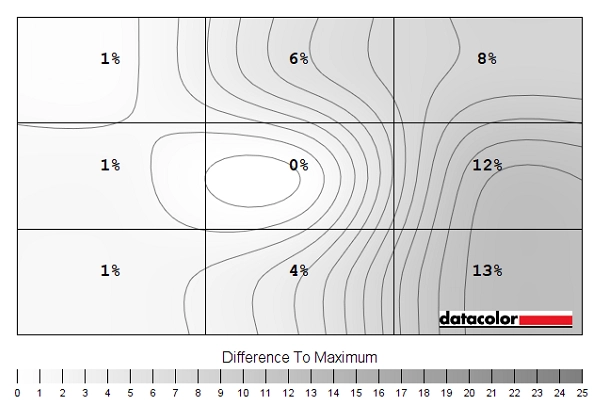
Luminance uniformity map
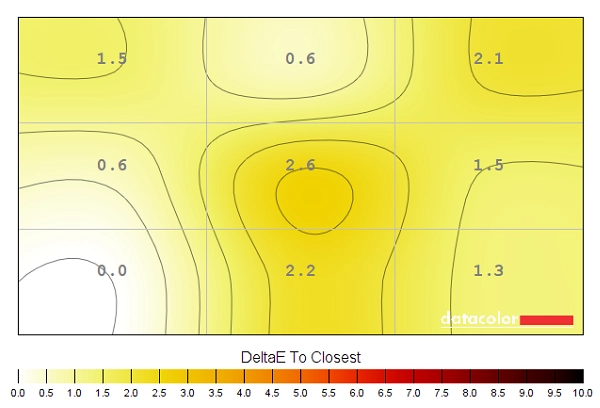
Colour temperature uniformity map
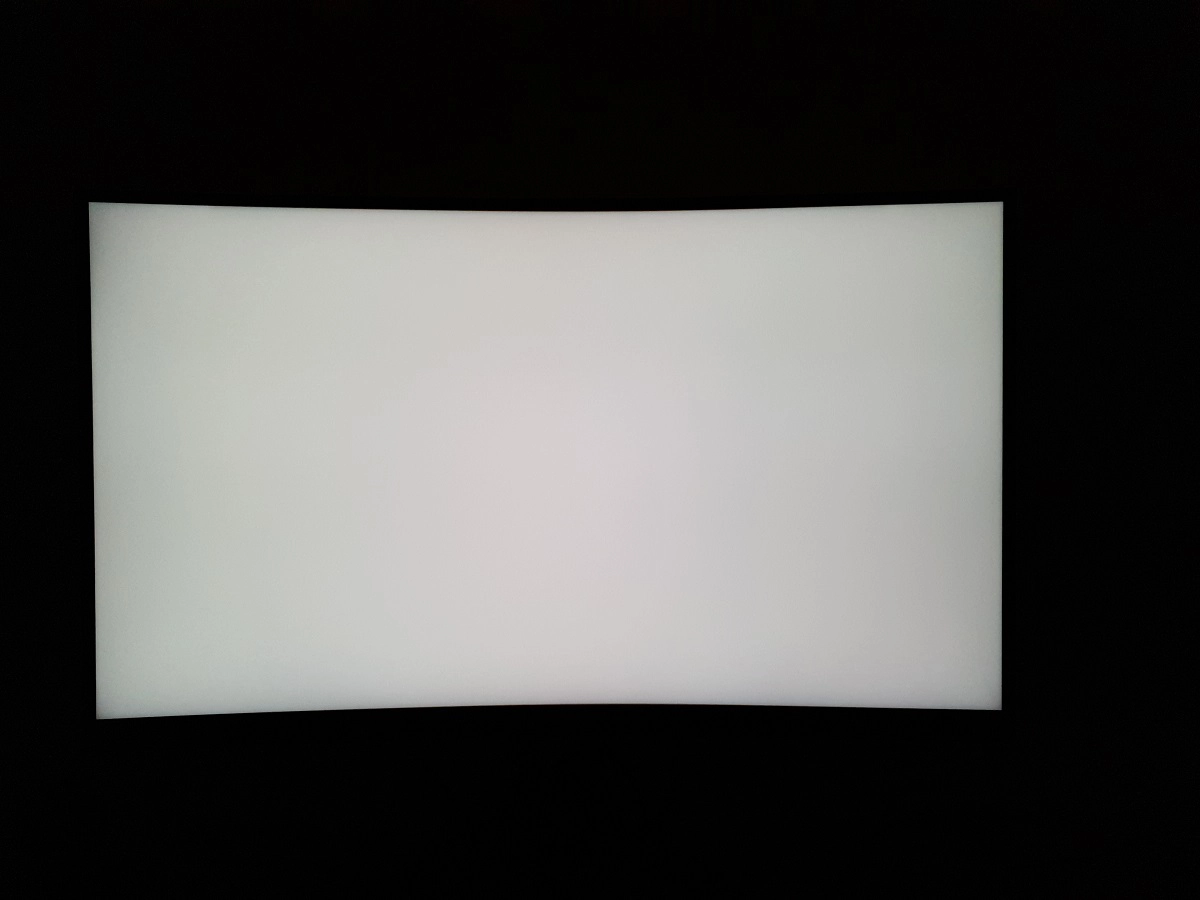
Contrast in games and movies
Lagom contrast tests
Colour reproduction
Colour gamut
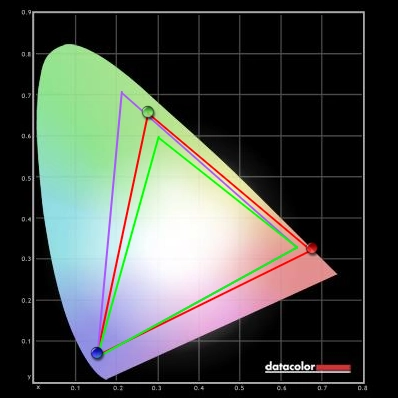
Colour gamut 'Test Settings'
The monitor also provides an sRGB emulation mode (setting ‘Color Temp.’ to ‘sRGB’ in the ‘Color Setup’ section of the OSD). This significantly cuts back on the colour gamut so that it more closely mirrors the sRGB reference space. As shown in the representation below, it does a decent job in this respect with much less over-extension than natively but a little under-coverage (97% sRGB). This would work as a more appropriate base of calibration for colour critical work within the sRGB colour space, for non colour-managed applications. But if you want full sRGB coverage and have your own colorimeter or similar device then you should stick to using the native gamut instead.
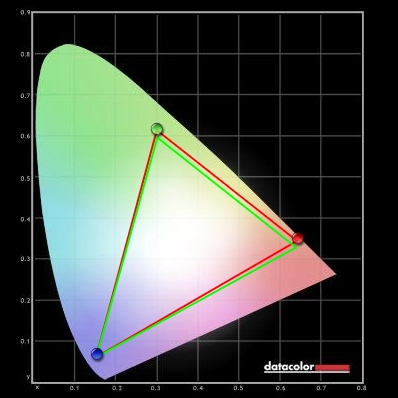
Colour gamut 'sRGB'
Colour in games and movies
Viewing angles
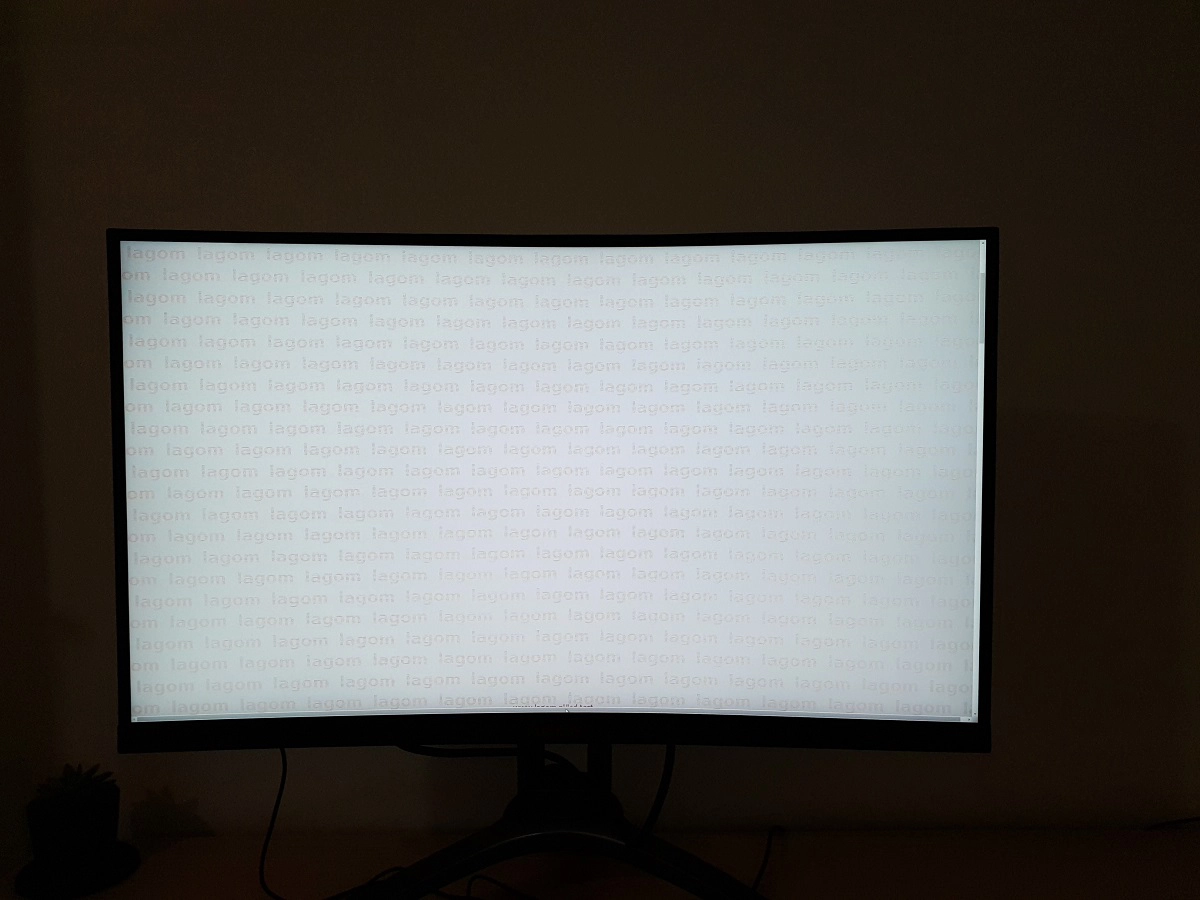
The following video shows the Lagom text test, a mixed desktop background and dark desktop background from various viewing angles. You can see some contrast and brightness shifts kick in off-angle, strengthening as the viewing angle increases. This is less extreme vertically than on TN models, which even show colour inversion beyond a certain point. But the shifts are more pronounced than on your typical IPS-type panel. The final section of the video highlights the ‘VA glow’ mentioned earlier, which blooms out off-angle but is less readily observed from a normal viewing position.
Interlace pattern artifacts
Responsiveness
Input lag
Perceived blur (pursuit photography)
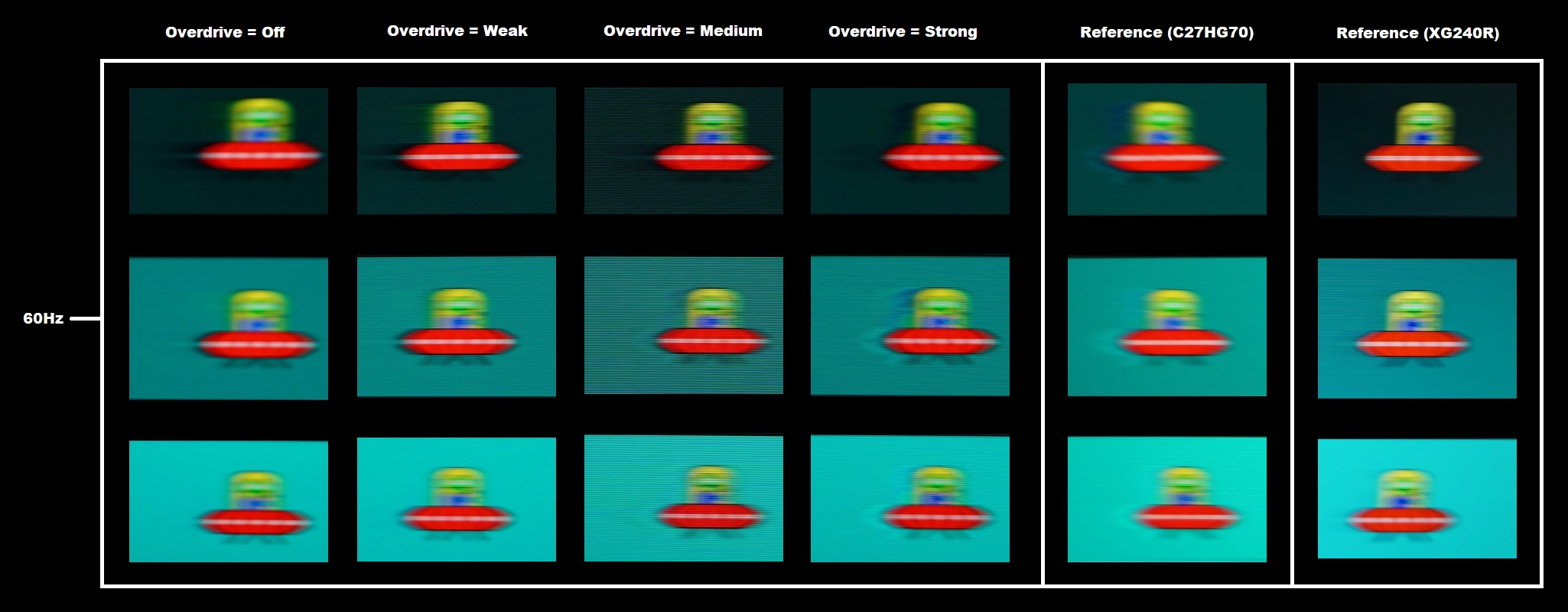
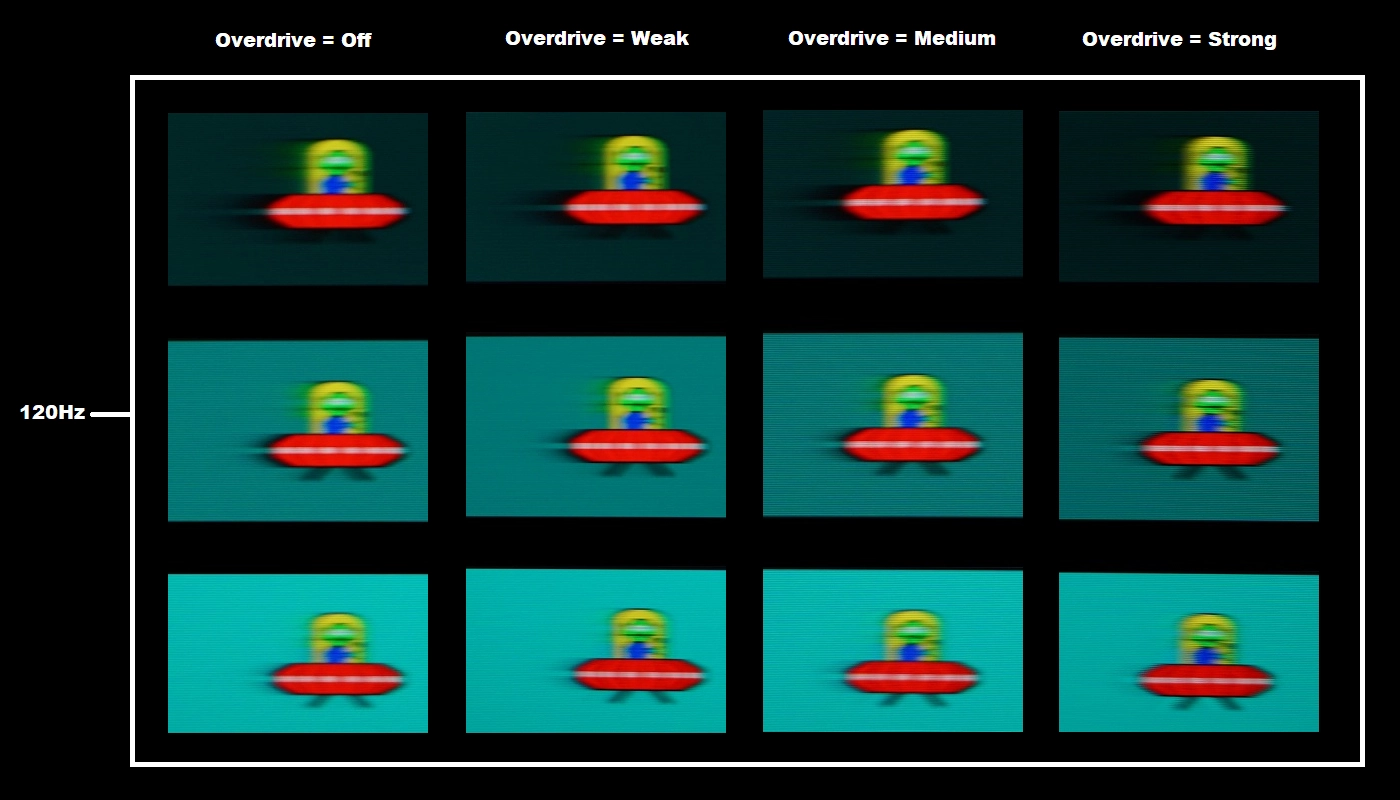
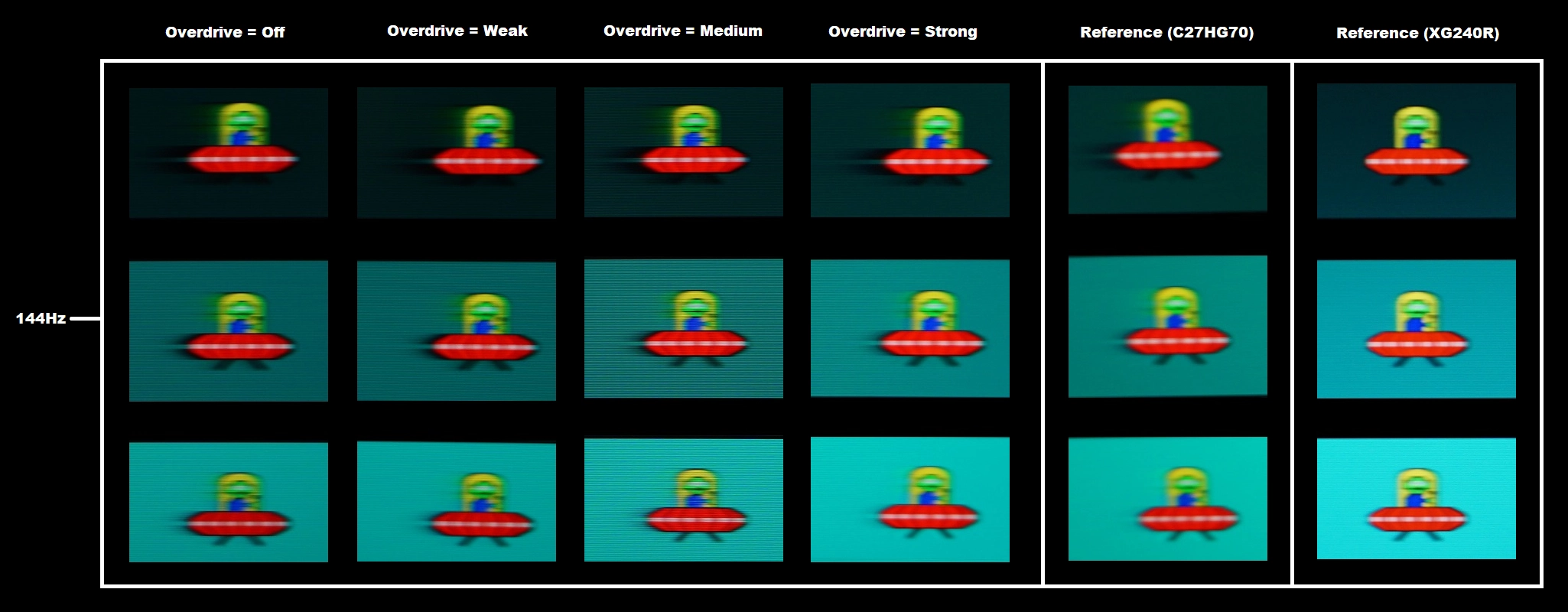
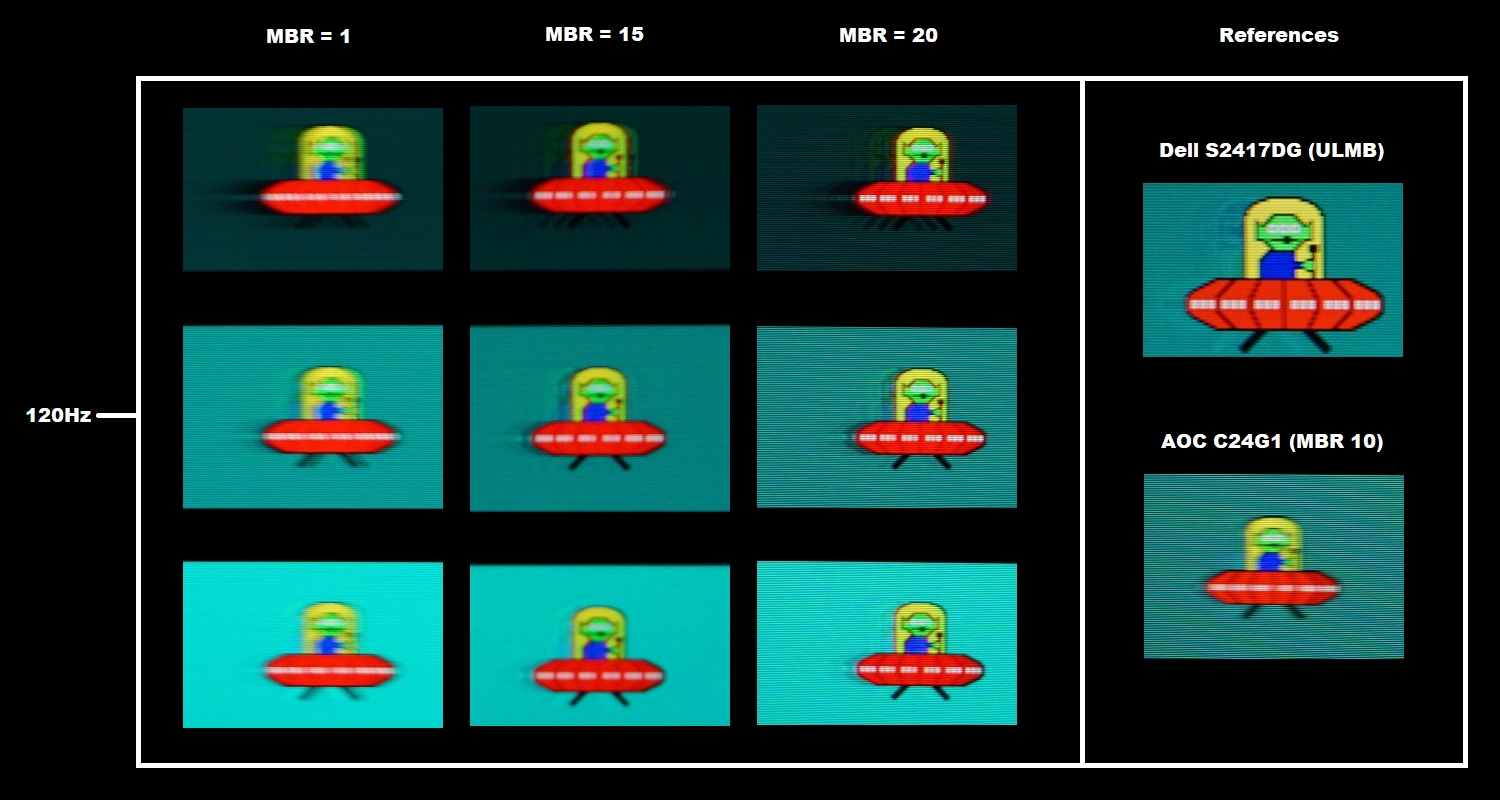
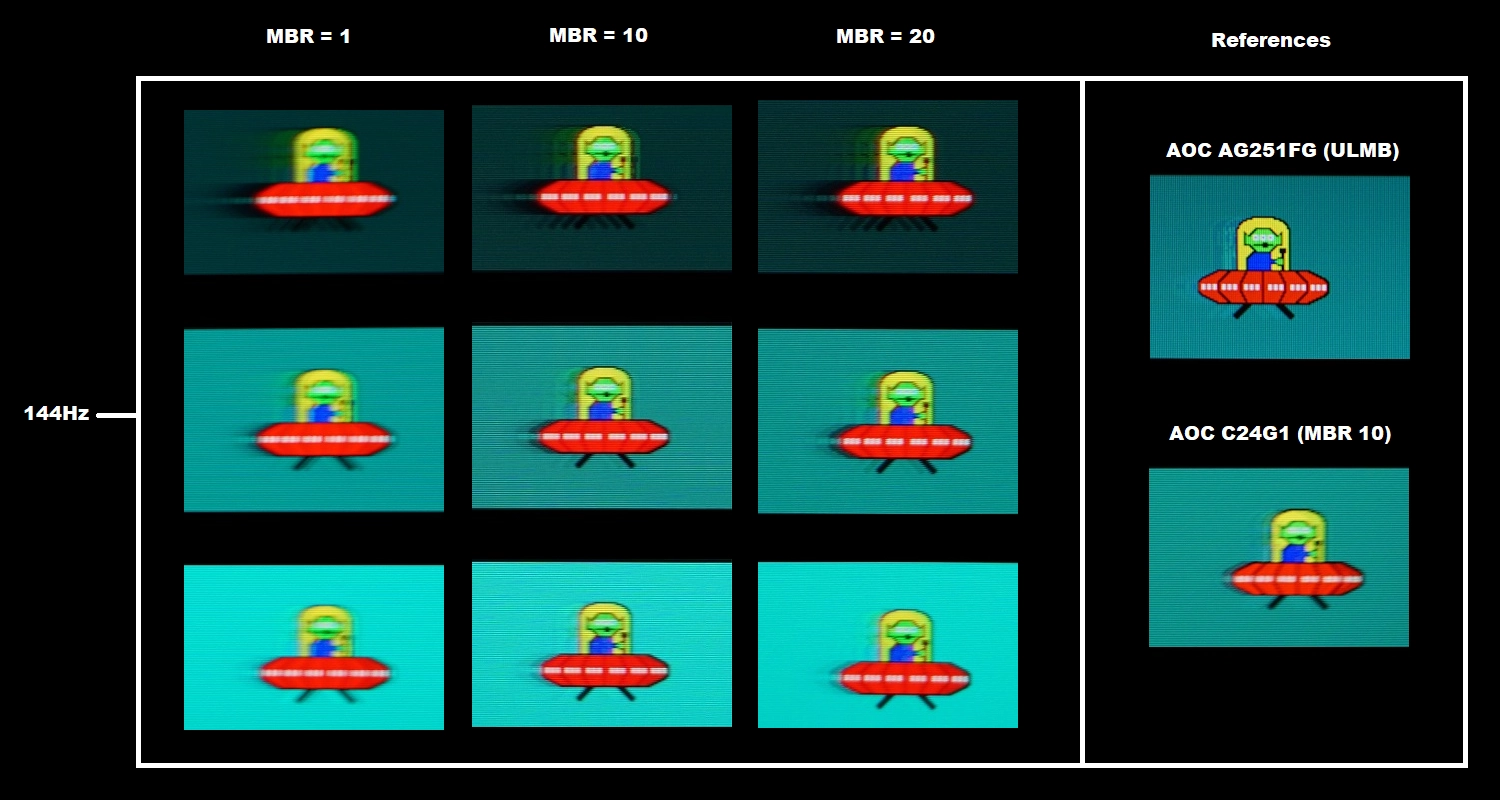

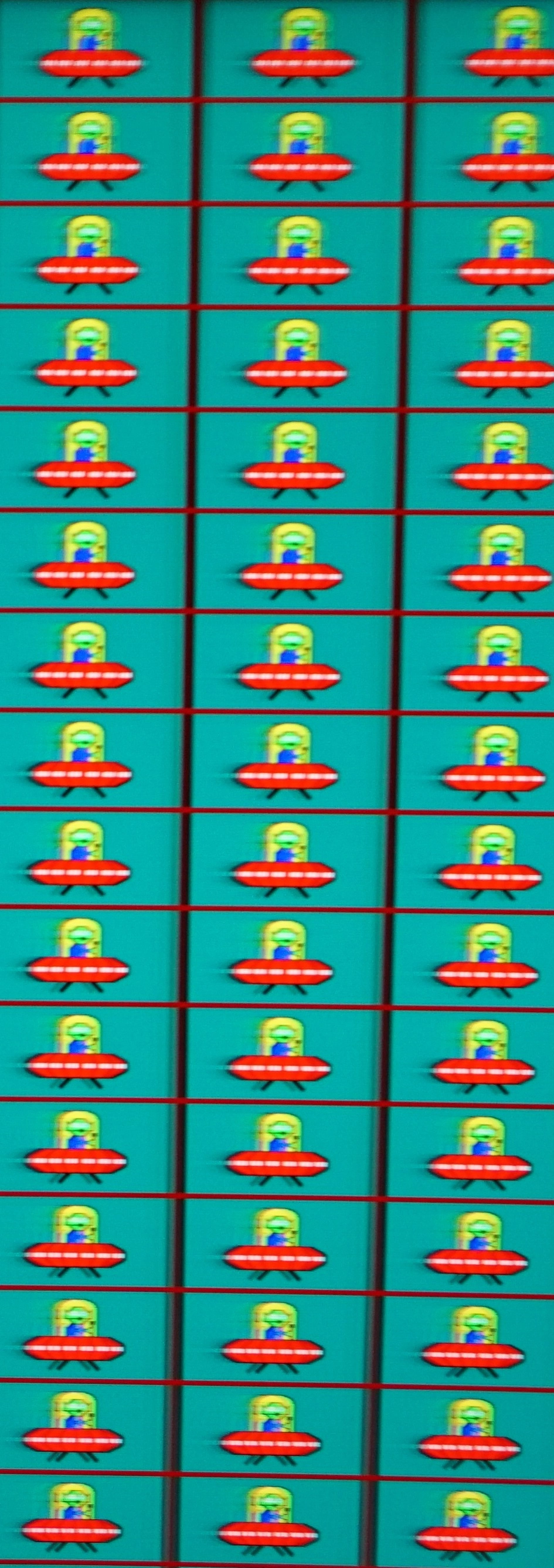
Responsiveness in games and movies
As mentioned in the above section of the video review, we consider the overall pixel on this model to be somewhere in the middle as far as VA models go. Somewhat weaker than what we observed on the Samsung C27HG70 and the AOC C24G1 (even using the ‘Medium’ overdrive setting there). And certainly weaker than on the LG 32GK850G, with appropriate settings. But improved compared to the likes of the AOC Q3279VWF. And quite in-line with the AOC AG322QCX, overall. We also made observations on Shadow of the Tomb Raider. These were largely similar to our observations on BFV and more broadly. This title had a large number of dark shades, with dimly lit interior areas, so ‘smeary’ trailing and ‘break-up’ trailing was quite common. Users probably won’t generally find it distracts too much from the gameplay on titles like this. It’s potentially a lot less bothersome than on titles like BFV, where the added perceived blur and removal of the competitive edge can be more of a nuisance.
FreeSync – the technology and activating it
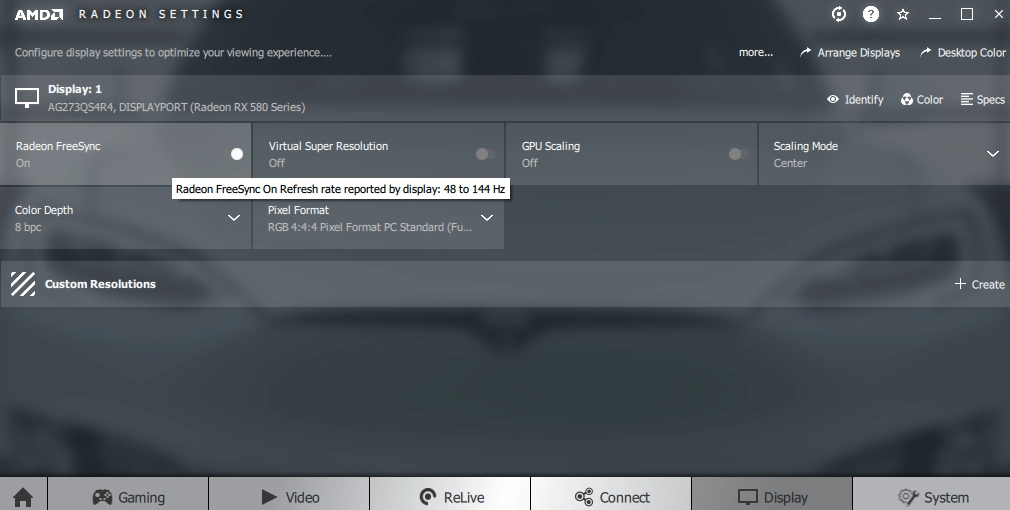
The AOC supports a variable refresh rate range of 48 – 144Hz. That means that if the game is running between 48fps and 144fps, the monitor will adjust its refresh rate to match. When the frame rate rises above 144fps, the monitor will stay at 144Hz and the GPU will respect your selection of ‘VSync on’ or ‘VSync off’ in the graphics driver. With ‘VSync on’ the frame rate will not be allowed to rise above 144fps, at which point VSync activates and imposes the usual associated latency penalty. With ‘VSync off’ the frame rate is free to climb as high as the GPU will output (potentially >144fps). AMD LFC (Low Framerate Compensation) is also supported by this model, which means that the refresh rate will stick to multiples of the frame rate where it falls below the 48Hz (48fps) floor of operation for FreeSync. If a game ran at 35fps, for example, the refresh rate would be 70Hz to help keep tearing and stuttering at bay. This feature is used regardless of VSync setting, so it’s only above the ceiling of operation where the VSync setting makes a difference.
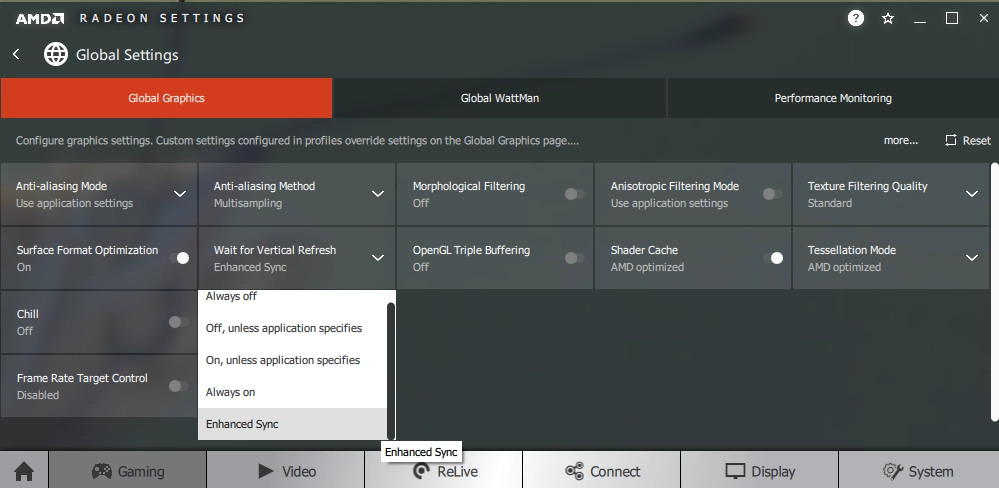
Some users prefer to leave VSync enabled but use a frame rate limiter set a few frames below the maximum supported (e.g. 141fps) instead, avoiding any VSync latency penalty at frame rates near the ceiling of operation or tearing from frame rates rising above the refresh rate. If you activate the ‘Frame Counter’ in the ‘Game Setting’ section of the OSD, this will display the refresh rate of the display and therefore indicate the frame rate if ‘FreeSync’ is active and the frame rate is within the variable refresh rate range of the display. Finally, it’s worth noting that FreeSync only removes stuttering or juddering related to mismatches between frame rate and refresh rate. It can’t compensate for other interruptions to smooth game play, for example network latency or insufficient system memory. Some game engines will also show stuttering (or ‘hitching’) for various other reasons which won’t be eliminated by the technology.
FreeSync – the experience
Nvidia Adaptive-Sync (‘G-SYNC Compatible’)

You will also see in the image above that it states: “Selected Display in not validated as G-SYNC Compatible.” This means Nvidia hasn’t specifically tested and validated the display, not that it doesn’t work. And indeed it did. We found the Nvidia Adaptive-Sync (G-SYNC compatible) experience much the same as using AMD FreeSync on this model in terms of the technology removing tearing and stuttering from frame rate and refresh rate mismatches. All of our observations regarding different refresh rate and frame rate ranges, somewhat increased overshoot as this reduces etc. also applies. As with FreeSync, HDR could also be activated at the same time if you like. The technology also worked with an LFC-like technology where the frame rate fell below the refresh rate of the display. The refresh rate stuck to a multiple of the frame rate, keeping tearing and stuttering from uneven divisions of the two at bay. There were notable differences compared to our experience with FreeSync on this model, however.
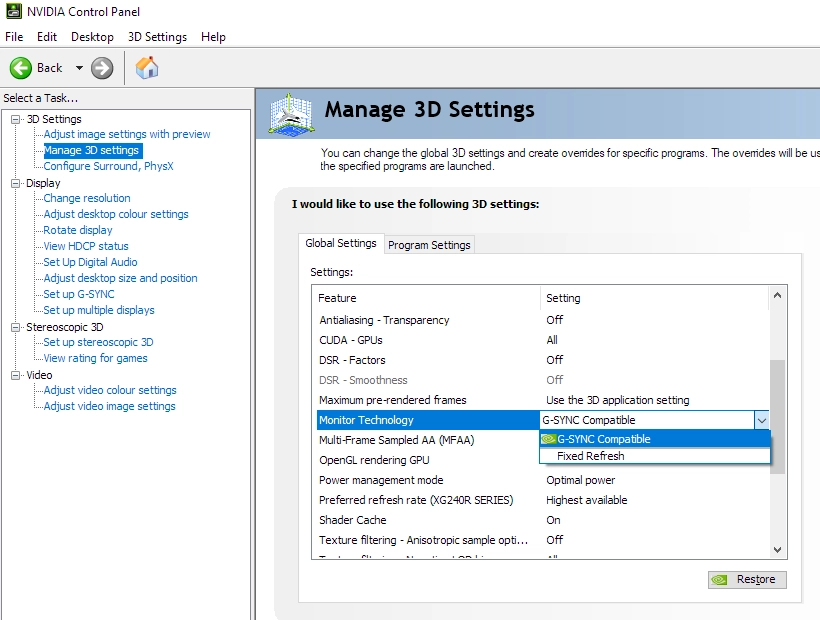
Finally, note again that you can activate the ‘Frame Counter’ feature in the ‘Game Setting’ section of the OSD to see if the technology is working. This will fluctuate as frame rate fluctuates, whereas if Adaptive-Sync isn’t being used it will stay at the static refresh rate you’ve selected. Given the issues with flickering and the pixel overdrive not functioning, some Nvidia GPU users will want to leave this technology disabled on this model. But sensitivity to flickering and overall motion performance varies so some users may find it beneficial regardless.
MBR (Motion Blur Reduction)
HDR (High Dynamic Range)
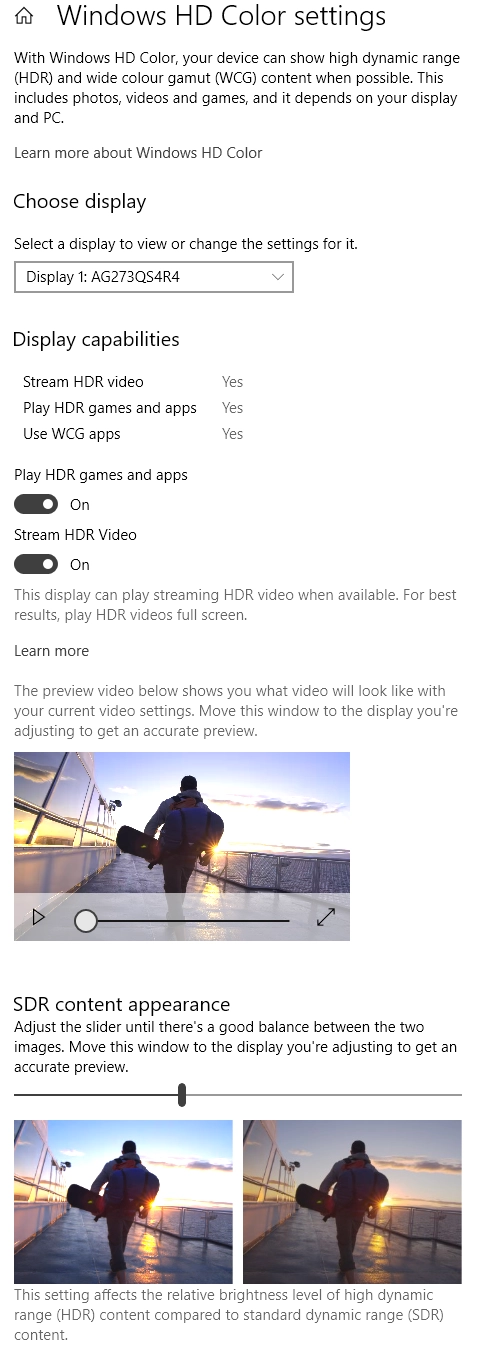

Colour gamut 'Test Settings'
The 27” 2560 x 1440 curved experience


Interpolation and upscaling

Video review
Timestamps:
Features & Aesthetics
Contrast
Colour reproduction
HDR (High Dynamic Range)
Responsiveness
Conclusion
Positives Negatives Vibrant but varied colour output and good overall balance after a little OSD tweaking Some perceived gamma and colour saturation shifts related to the VA panel Strong overall contrast performance, delivering a good atmosphere to dark scenes ‘VA glow’ and ‘black crush’, although not extreme amongst VA panels of this size. Slight graininess to the screen surface Fairly low input lag and a 144Hz refresh rate to give a good ‘connected feel’, and Adaptive-Sync working for both AMD and Nvidia users to get rid of tearing and stuttering from frame and refresh rate mismatches Some distinct weaknesses in pixel transitions, particularly where darker shades are involved and some flickering issues using Adaptive-Sync (more so for Nvidia GPUs) A very solid and ergonomically flexible design and a decent HDR implementation as far as VESA DisplayHDR 400 goes Stand base is quite deep, ‘Light FX’ lighting could do with being a bit brighter and there is no local dimming to really enhance the HDR experience
As an Amazon Associate I earn from qualifying purchases made using the below link. Where possible, you’ll be redirected to your nearest store. Further information on supporting our work.


